

Highlights of Romania
- Accommodation
- Exclusive Tour
- Fortified Churches
- Holiday in Maramures
- Holiday in Transylvania
- Holiday to Romania
- Meals included
- Medieval Castles
- Medieval Cities
- Private Tour
- Saxon Villages
- Tours in Maramures
- Tours in Romania
- Tours in Transylvania
- Traditional Villages
- UNESCO World Heritage Sites
- Wooden Churches
DISCOVER THE BEST OF MARAMURES AND TRANSYLVANIA IN 9 DAYS
Embark on a 9-day adventure exploring the cultural treasures and historic sites of Maramures and Transylvania. This comprehensive tour offers a deep dive into the region’s rich heritage, from the iconic wooden churches of Maramures to the medieval citadel of Sighisoara and the legendary castles of Transylvania.
Highlights include a journey through the beautiful landscapes of the Carpathian Mountains, unique encounters with local traditions, and immersive experiences such as a traditional Romanian folklore show. With expert guidance, comfortable accommodations, and a personalized itinerary, this tour promises an unforgettable exploration of Romania’s most cherished regions. Whether you’re a history buff, culture enthusiast, or nature lover, this tour caters to all interests, ensuring a diverse and enriching travel experience.
The tour can be personalised according to your time and points of interest.
Itinerary : Bucharest Arrival – Olt River Gorges – Cozia Monastery – Sibiu Walking Tour – Corvin Castle – Alba Iulia Citadel – Turda Salt Mine – Cluj-Napoca Walking Tour – Organic Smoked Bacon Tasting with Lunch – Wooden Churches of Maramures – Home Hosted Dinner – Aighetu Marmatiei Communism Memorial – Sapanta Merry Cemetery – Sapanta Peri Monastery – Dinner with Folklore Show – Barsana & Ieud Wooden Churches – Woman Museum – Borgo Pass – Exclusive Gypsy Home Visit – Sighisoara Walking Tour – Saxon Village of Saschiz & Viscri with the Fortified Churches – Exclusive Viscri Village Tour & Traditional Lunch – Wildness Bear Observatory – Bear Sanctuary – Bran Castle – Brasov Walking Tour – Peles Castle – Bucharest Departure
TOUR HIGHLIGHTS AND UNIQUE CULTURAL CONNECTIONS
- Immerse in the Past: Experience the rich cultural tapestry of Romania by visiting ancient sites and engaging in traditional practices.
- Sibiu’s Historical Richness: Wander the old streets of Sibiu, exploring its grand squares and viewing houses with the iconic “Sibiu eyes.”
- Majestic Castles: Tour the famous Bran Castle and the luxurious Peles Castle, each with its unique story and breathtaking architecture.
- Maramures Wooden Churches: Discover the remarkable wooden churches of Maramures, showcasing unique gothic-style timber constructions that are recognized as UNESCO World Heritage Sites.
- Bear Conservation: Visit a sanctuary dedicated to rescuing and rehabilitating bears, providing insights into wildlife protection.
- Sighisoara Medieval Charm: Explore the birthplace of Vlad the Impaler, a well-preserved medieval citadel also listed as a UNESCO World Heritage Site.
- Artisanal Craftsmanship: Witness traditional blacksmithing in Viscri and participate in an egg-painting workshop, preserving centuries-old crafts.
- Gypsy Culture: Gain unique insights into the Roma community with an exclusive home visit, learning about their traditions and way of life.
- Scenic Train Rides: Enjoy a memorable ride through the picturesque landscapes of Romania on a historic steam train.
- Folklore Evenings: Experience authentic Romanian culture with dinners accompanied by traditional folklore shows in Maramures.
Day 1: Bucharest Arrival
Day 2: bucharest – olt river gorges – cozia monastery – sibiu walking tour.
Embark on an enriching journey as you depart Bucharest and head towards the picturesque region of Transylvania after you meet your certified English-speaking guide. The day’s adventure begins with a scenic drive through the lush landscapes surrounding the Olt River, Romania’s longest river. As you navigate through the stunning Olt River Gorges, take in the majestic views of steep cliffs and dense forests that line this historic waterway, offering ample opportunities for breathtaking photos. Your first stop is Cozia Monastery, nestled on the banks of the Olt River. This architectural gem, built by Mircea the Elder in 1388, is one of the oldest and most significant Orthodox monasteries in Romania. Explore the monastery’s well-preserved frescoes and the serene grounds, providing a peaceful glimpse into the spiritual heritage of Romania. Continue your journey to Sibiu, a cultural and historical hub once the capital of Transylvania. Upon arrival, engage in a guided walking tour of this charming city, known for its Germanic architecture and the iconic ‘eyes of Sibiu’—small attic windows that resemble watching eyes, adding to the city’s enchanting atmosphere. Wander through Sibiu’s main squares—Piața Mare and Piața Mică—lined with colorful houses and bustling with activity. Visit key landmarks like the Brukenthal National Museum and the Lutheran Cathedral, where you can climb the steeple for panoramic views of the city and beyond. After a day filled with natural beauty and historical exploration, settle into your accommodation in Sibiu. The evening offers the perfect opportunity to further explore the local cuisine and vibrant culture of this beautiful city, setting the tone for the rest of your memorable journey through Romania.
***Summer Variation: The Transfagarasan Highway Adventure During the summer months (July to November), your journey to Sibiu takes an adventurous turn with a drive on the spectacular Transfagarasan Highway. Hailed as “the best road in the world” by Top Gear, this route offers an unforgettable experience with its stunning mountain vistas and serpentine paths. As you ascend to Balea Lake, situated at 2,034 meters, the breathtaking landscapes of Romania unfold before you. A stop at the Poenari Citadel, the real stronghold of Vlad the Impaler, adds a historical dimension to your journey. Perched high on a cliff, the citadel’s ruins offer not only a glimpse into the past but also panoramic views of the surrounding mountains.
Day 3: Corvin Castle – Alba Iulia Citadel – Turda Salt Mine – Cluj Napoca
Day 4: cluj napoca walking tour – organic smoked bacon tasting with home-made lunch – surdesti & budesti wooden churches – home hosted dinner in maramures, day 5: exclusive walking tour – sighetu marmatiei – communism memorial – sapanta merry cemetery – sapanta peri monastery– dinner with folklore show, day 6: barsana & ieud wooden churches – woman museum – borgo pass – exclusive gypsy home visit – sighisoara, day 7: sighisoara walking tour – saxon village of saschiz & viscri with the fortified churches – exclusive viscri village tour & traditional lunch – wildness bear observatory, day 8: bear sanctuary – bran castle – brasov walking tour, day 9: peles castle – bucharest departure.

Traditional Romanian welcome dinner with Folklore Show
In the evening, you can opt to serve a traditional dinner at a local restaurant with an idyllic view, situated on the lakeshore in Bucharest’s most famous park, the Herastrau or Michael I Park. Here, you will enjoy a three-course meal dinner with wine included, and you will get a chance to discover the traditional Romanian folklore costumes while enjoying the dances of the local performers. The entire show displays authentic Romanian traditions and customs, from the sewn details on the white outfits of the dancers to the delighting music played by the local artists.
Three-hour trip in Ukraine, to Solotvina and Nyzhnya Apsha
After Sapanta Peri Monastery visit, you can chose to visit the Ukrainian Maramures with a visit to Solotvina, which is the Ukrainian part of the Romanian town. And you will have the chance to visit Nyzhnya Apsha village. This region was in Transylvania until 1920.
Extra full day Bucharest City Tour
After the breakfast, we will start the visit of the capital city of Romania. The day starts with a visit to the Village Museum, one of the most impressive open-air museums in Europe with century old original peasant households from all parts of Romania. After, we will visit the world’s largest, heaviest and most expensive administrative building, the Palace of Parliament. Between the two communist landmarks, we will have a panoramic tour of the city with Victory Square and Avenue, Royal Palace and Revolution Square and a short stop and visit of the Romanian Athenaeum. Next, we will attend a visit to the former residence of Ceausescu family, the last communist leader of the Socialist Republic of Romania. In contradistinction with the Ceausescu former residence we will have an incursion back in time, in the communist time, where you will have the opportunity to experience life in the 80’s with the help of authentic decor and furniture, working appliances and household accessories, local drinks and homemade snacks and historical and archive footage. Before arriving in the old city center we will stop in the Cotroceni Neighborhood where we will visit the Presidential Palace and a typical 1930s Bucharest Residence. In the late afternoon, we will reach Bucharest’s Old Town, with the ruins of the Old Princely Court, known as Dracula’s residence, where the legend says that Vlad the Impaler was keeping his prisoners. We will take a sightseeing tour of this part of the city, filled with lively cafes and street food to see why the nickname of Bucharest is “The Little Paris”. The rest of the evening is on your own.
Three day Republic of Moldavia Extension with Tiraspol Tour
Extra day 1: bucovina – iasi city tour – soroca, extra day 2: soroca fortress – old orhei with traditional lunch – cricova wine cellars – chisinau city tour, extra day 3: bender fortress – tiraspol tour – bucovina.

Tour Reviews
4 of us went on a bespoke tour of Transylvania organised by Holiday to Romania and Vlad Cernaianu. We had an excellent, well informed, guide who drove us around in a spacious comfortable people carrier. Our trip was a mix of what we knew we wanted to do and what Vlad wisely recommended which proved the perfect mix. We found Romania to be the most lovely country with extensive forests and wildlife areas and charming cities – especially Sibiu and Sighisoara – and were seriously impressed by the renovation of older buildings and associated attention to detail. The cities were clean and well maintained with plenty of outdoor entertainment as well as some ‘folk’ events. The local wine was excellent and the food fine but nothing special. We thoroughly recommend Transylvania and Holiday to Romania as company to organise this for you. Vlad replied very promptly to our enquiries and communicated well to ensure we had the holiday we had hoped for.
Leave a Review
Cancel reply.
Please enter an answer in digits: eight − eight =
You May Also Like
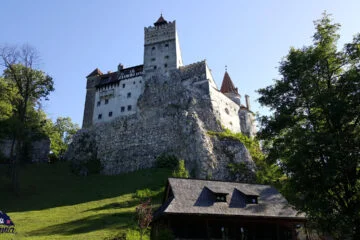
Explore the Magic of Brasov

Dental Treatment in Romania

Timeless Treasures of Romania
Privacy overview.
Early Booking Rates for 2024 Tours. Enquire now!

Maramures Tour
Private tour of Maramures, starting at 300 EUR/person/day
Maramures, the ultimate bucolic nest of Europe
Escape modernity, in comfort, on a discovery journey through wild landscapes and enchanting villages. Witness a way of life that has disappeared from almost every corner of Europe and experience some of the finest hospitality anywhere on the continent.
WHY VISIT MARAMURES
If you’re longing for sense, purpose, archaic essences and values “craft”-fully mixed with fairytale landscapes and unadulterated people and tastes, then make Maramures your home for a few days.
This terra incognita, separated from the rest of Romania by a crescent of mountains and a plethora of beliefs and traditions, is the perfect escape from neurotic modernity into a genuinely old time, where the delicate balance between man and nature still holds.
>> A brilliant article about slow living in Romania here <<
Uncover the charm and spiritual side of this corner of Romania on truly unforgettable, culture packed private tours of Maramures. You’ll see the very best of this unexplored swath of continental Europe as we unlock the doors to a host of amazing experiences.
WHAT’S IN STORE FOR YOU
Start off in vibrant Cluj where you’ll be immersed in the city’s exciting and artistic blend of old meets new . Next we’ll whisk you north, away from the urban hubs and into a bubble of villages and river valleys where the people of the land preserved a bucolic way of life in a landscape so little altered by the incursions of industrial modernity .
We’ll take you along back roads threaded between dromedary hills and wildflower meadows dotted with haystacks and pricked with wooden church spires. You will meet traditional artisans, old-school craftsmen and unreconstructed farmers , bake and break bread with the local families and find peace and serenity in some of the most beautiful UNESCO-listed churches in Maramures .
And, in case you oenophiles and foodies were starting to wonder: yes, you will sample some of the freshest and most delicious organic meals pared with the best of the local wines in some of the most charming traditional guesthouses.
>> More about Romanian food habits and gastronomy here <<
ITINERARY SUGGESTION
- D2 : Cluj – Banffy Castle – Beclean – Sacel – Viseu de Sus (3h30 drive)
- D3 : Viseu de Sus – Ieud – Poienile Izei – Barsana – Vadu Izei (2h drive)
- D4 : Vadu Izei – Sighetu Marmatiei – Sapanta – Breb (1h30 drive)
- D6 : Breb – Targu Lapus – Rohia – Cluj (3h drive)
*Driving times don’t include stops.
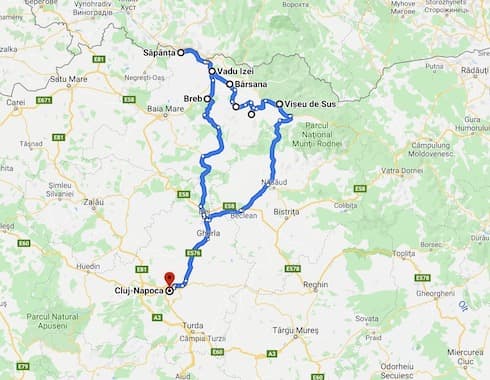
IMPORTANT NOTICE
Please note that this is merely an itinerary suggestion, the backbone of a possible tour. We don’t do one-size-fits-all trips, we design the experience for you from the scratch when we know the length of your trip and what sparks your interest. Culinary discoveries, plant foraging, horse-riding, biking, hiking, local events, traditional crafts, wine tastings, architecture, you name it and we’ll arrange it. We have a nice and customisable selection of activities that we’ve gathered by doing our own research, a few of them are listed right here under Optional Extras.
- Private airport transfers and transportation throughout your tour in a modern air-conditioned car
- Professional English speaking guide – driver
- Accommodation based on sharing room in some of the most charming boutique hotels and traditional houses in the area
- Half board meal and beverage plan (breakfast and lunch or dinner)
- Water during the day
- Entrance fees to museums and churches
- Personal shopping
- Other beverages than those included in the half board plan and presented on the table
- Travel insurance
- Visas (if required)
- Optional extras
Maramures will bewilder and charm you regardless of the length and depth of your journey, but it will win your heart for good if you take the time to dig deeper and connect the right dots. Below are some add-on ingredients to spice up your trip:
- Traditional home cooking class in a small village, where you’ll learn to cook like a local.
- Dinner in a local home with a local family
- Workshops in the fine art of pottery, wood carving, beaded jewellery, weaving and traditional masks making.
- Medicinal plants, wild fruit or mushroom foraging, depending on the season.
- Visit to a local plum brandy distillery to taste and learn how it is done.
- Panoramic picnic with organic local delicacies and seasonal produce. A local folk musician may enhance the experience if you wish so.
- Hiking in the scenic mountains nearby.
- Light walking in the fields and beautiful countryside.
- Horse-drawn carts or sleigh rides.
- Romania Private Tours is all about bespoke experiences , so don’t think of this as a “prêt-à-porter” itinerary, but as a blueprint of one of the countless possibilities. To find out more, get in touch with us for a tailor-made trip based on your budget and interests.
- Please note that all our tours of Romania are private and we may stop along the way as often as you desire, for you to visit a site, take a stunning photo or simply engage with the people of the land.
- The optimal duration of a tour is min. 3 nights.
- Group size: min.2, max.6 persons
- Price varies according to the number of persons and it starts at 300 EUR/person/day and it includes the services mentioned under WHAT IS INCLUDED.
TAKE A PEEK
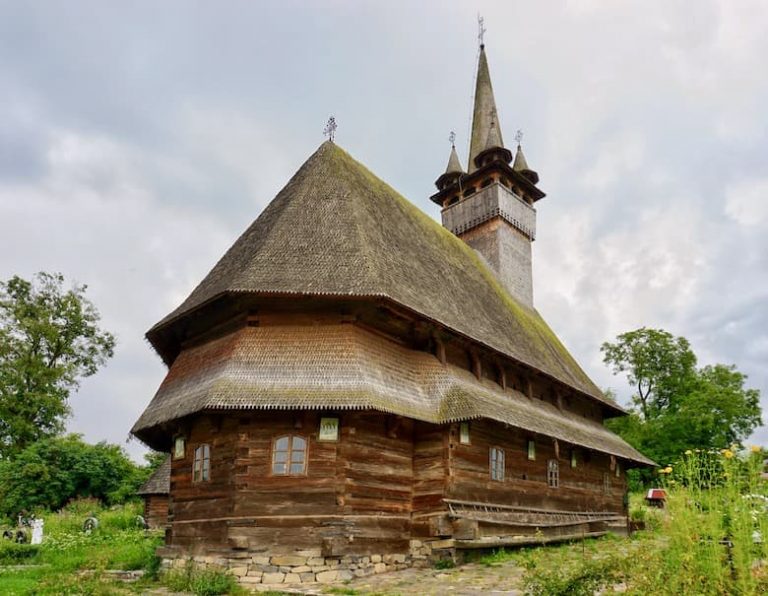
Ready to reboot and recharge?
We caught the travel bug at a very young age and we were travel junkies before becoming travel professionals. We experienced the highs and lows of this “addiction” and we’ve learned what ropes to pull to spike the ups and ditch the downs. Besides, Romania is our backyard: we’ve breathed it, known it, loved it since we were born. What makes us experts is the combination of both. We put ourselves in your shoes and we use our insider knowledge to make them fit.
You certainly can, if you have the time and you don’t mind the little imperfections. In theory, anyone can do that, just as anyone can fix something to eat to ease his hunger. But planning a fabulous trip, in perfect harmony with your time, budget, interests and expectations requires expertise, timing and time. If you’re short on any of the above and don’t want to risk blowing your trip, then hiring the right people is the best investment.
If you’re a family (ideally smaller than Ziona Chana’s) or a group of friends, the answer is yes. Just tell us the group size and what your interests are and we’ll design a memorable journey.
To ensure a smooth and uneventful tour we’ve learned that it’s paramount to be in control of all ingredients, hotels being one of them. That being said, we will offer you several options, if available, leaving you the final call.
Unfortunately not. All of our tours are private and tailor-made.
Booking flights is not our area of expertise, but we can gladly advise you on the best way to get to Romania or refer you to a specialised agency.
We recommend that you seek the assistance of a qualified insurance broker in your country of residence.
For full pricing and payment details, please read our Terms & Conditions.
Privacy overview.
Visit Maramures: 10 Things to Do in the Land of Wood
Home » Visit » Travel Ideas » Visit Maramures: 10 Things to Do in the Land of Wood
- Attractions in Maramures
- Editor's Pick
- Travel Ideas
- authentic experiences
- things to do
- travel tips
Diana Condrea
Check our Walking Tour in Maramures .
Maramures or the ‘land of wood’ is a destination you should visit at least once in your lifetime. Located up north, on the border with Ukraine, Maramures is famous for its original wooden architecture . UNESCO-listed wooden churches, massive wooden gates, traditional houses, and installations are all wonderful results of its particular use of wood .
Woman wearing traditional clothes, Botiza
Even better, Maramures offers great outdoors, perfect for walking, cycling, and hiking, our favorite ways to visit Maramures .
Without further ado, here’s our list of the best things to do in Maramures, the ‘land of wood’.
1. Walk or cycle from village to village
This is the best way to visit Maramures, following the routes villagers used for generations . You can ask locals to show you the most beautiful shortcuts or you can follow one of the many trails from the Greenway Maramures network . The 88 km connects seven villages, seven protected areas, and two NATURA 2000 sites.
Walking on the trails to Creasta Cocosului
If you prefer cycling, there are six marked cycling trails:
- the Rooster’s Crest Trail (7.5 km difficult)
- the Rooster’s Crest – Budesti Trail (22 km difficult)
- the Rosia Trail (15.7 km medium and difficult)
- the Cosau Trail (15 km easy and medium)
- the Rails’ Trail (20.8 km easy and medium)
- the Ignis – Mara Trail (25 km difficult)
If you need even more adrenaline, you can also try paragliding while you visit Maramures.
Walking from Harnicesti to Sugatag village
2. Visit the UNESCO World Heritage Sites
If you’re fascinated by the architectural style of the wooden churches, don’t miss a complete tour of these landmarks . They’re the best examples of how locals’ knowledge in carving wood ensured their survival for centuries .
You’ll find the eight wooden churches from the UNESCO Heritage List in Barsana, Budesti, Desesti , Ieud, Plopis, Poienile Izei, Rogoz, and Surdesti.
Rogoz Church
3. Meet the local artisans
Don’t forget to include trips to local artisans who bring to the present old crafts techniques.
Start in Sarbi where a themed itinerary connects the houses of artisans Vasile Borodi, Victoria Duma, Petru Pralea, and Gheorghe Opris . In the same village, you’ll see old installations powered by water, including a traditional whirlpool like the ones used until a few decades ago .
In Barsana, you can visit the workshop of the wood artisan Toader Barsan, while in Botiza you can admire carpets and embroideries in the small museum of Victoria Berbecaru .
The list of artisans doesn’t end here. You’ll find more talented locals who carry on creating beautiful artisan products with only their hands and simple tools .
4. Discover the authentic wooden houses and gates
The typical wooden houses of Maramures are, unfortunately, on a fast track to becoming exotic reminders of the past . Fewer and fewer, these traditional houses were made from oak and fir tree wood and had tall roofs covered with shingles . Still, you can see enough if you take your time to walk around the villages.
Traditional house, Desesti village
If you have the chance to walk inside, admire the simple lifestyle locals had until just a few decades ago. The porch, a small hallway known as tinda , a room for daily family life, and a guest room used to display the hand-worked dowry of the girls usually made up the entire house.
Like the houses, the wooden gates, elaborate and imposing, were once the symbol of their owner’s social status and of the sculptor’s talent.
5. Stay in a local guest house
A big part of your experience in Maramures will depend on where you choose to stay. We always recommend the small guest houses where the hosts take their time to prepare delicious home-cooked meals, and where you, the tourist, are treated like a friend .
Mara Guest House from Desesti is one of these great options. Located on the shore of the Mara River, with a large garden and the best food, this guest house is our favorite when we visit Maramures .
6. Discover Sighetu Marmatiei
First mentioned in 1325, Sighetu Marmatiei was for a very long time the only town in Maramures. Despite its provincial atmosphere, the small town witnessed the repercussions of the two dreadful extermination ideologies of the 20th century: nazism and communism. We recommend you save an entire day to visit the Village Museum and the Memorial of Victims of Communism organized in the former prison. Stop also at the Memorial House Elie Weisel and the Jewish Cemetery.
Sighet Memorial
7. Savor local gastronomy
The local dishes from Maramures are a mouth-watering delight not to miss. Moderation is, however, the keyword as some recipes are a bit too much if you’re on a light diet.
The most famous local dishes are meat and cheese-based. Try the local sausages and meat specialties like toba , caltabos, or slanina , the chicken soup, the local stew from a mix of meats served with polenta, and, of course, balmos , a nutrient meal from corn and sour cream.
Don’t forget to spice your meal with a shot of horinca , the strong local version of plum brandy. Don’t even try to refuse it, your hosts will feel offended as this homemade drink is their most famous specialty.
8. Visit the Merry Cemetery
Founded in 1935 by Stan Ioan Patras, the Merry Cemetery from Sapanta became a world-unique attraction for its unique view of death .
This is the place where the end is painted in shades of blue and written in funny words about the life of the dead. It’s the ancestral peasant philosophy of viewing death, not as a tragedy, but as a normal phase of life on earth.
The Merry Cemetery
9. Hike in the Carpathian wilderness
If you’d like to add a few hikes to your travel plans, you chose the right place. You have many options, from long and high-altitude routes to easy hikes for the entire family.
Go hiking in the Rodnei Mountains , the second-largest national park in Romania, if you’re in search of a challenge. With altitudes above 2,300 meters and iconic glacial lakes, this is the highest area of the Eastern Carpathians. Choose Maramuresului Mountains Nature Park if you’re looking for less strenuous hikes. With lower altitudes, under 2,000 meters, this protected area has over 170 km of marked trails, including three cycling routes. For family hikes, explore the Gutaiului Mountains and follow an easy route to their tallest peak, Creasta Cocosului .
Read also Trekking in Romania: Get Ready for a Real Adventure
Creasta Cocosului Peak
10. Take a train ride with Mocanita
The steam train Mocanita will take you on a wonderful journey, on the last forestry railway station in Europe, deep in the forests of Vaser Valley . The train, used since 1932 for transporting timber, runs on a narrow-gauge track of 760 mm, offering a memorable experience . And a unique one as Romania is the last European country where the forestry railways survived after WW2. In 1989, 15 routes still existed, but, except for Mocanita, all were closed down in the last decade of the 20th century .
For the schedule, check on www.cffviseu.com
We hope our guide to the best things to do in the ‘land of wood’ will help you make the best of your time for a great vacation.
TAKE ME THERE
Walking tour in maramures, romania heritage tour, related posts, our top reasons to visit bucharest as soon as possible, best things to do in romania for first-time visitors, bran castle: on the footsteps of queen maria and princess ileana, leave a reply cancel reply.
Your email address will not be published. Required fields are marked *
Save my name, email, and website in this browser for the next time I comment.
I have read and accepted the Privacy Policy *
- No translations available for this page
Automated page speed optimizations for fast site performance
- Get in touch
- +40746 933 659
- [email protected]

Maramures Tour
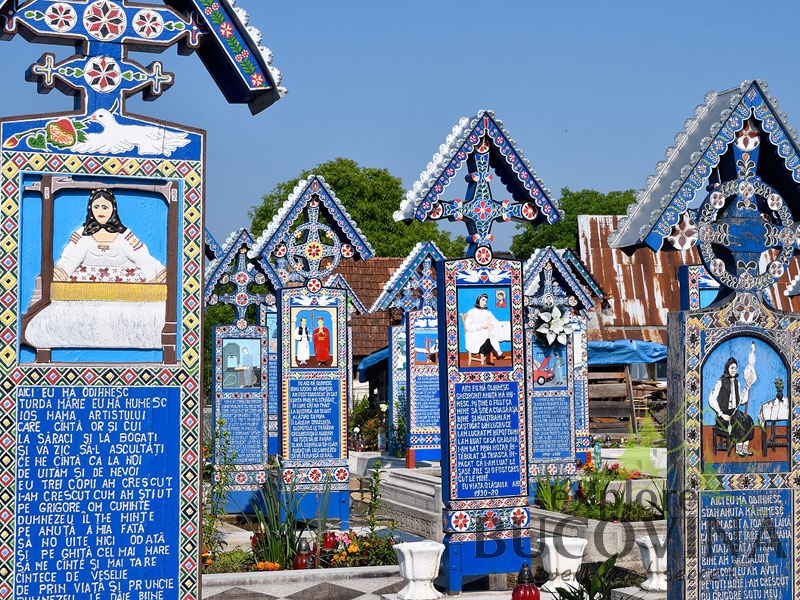
Availability - All year round
Time - 2 days
Distance - 430km – 720km of scenic roads and beautiful landscapes
Group size - from 2 to 7 or private
Price range - 100 - 180 Euro/ person
Maramures tour price:
1 pers - On request 2 pers - 180 Euro/person 3 pers - 120 Euro/person 4-7 pers - 100 Euro/person
What's included:
- Licensed english speaking tour guide; - Private transportation with modern vehicle (AC); - Pick up and drop off from your hotel. - 24/7 Assistance
Not included:
- Accomodation in a lovely homestay in Botiza village with half-board: dinner&breakfast with local products; - Lunch; - Entrance fees; - Personal expenses.
Maramures Tour description:
Maramures Tour is a 2 - day private tour that will allow you to step back in time and discover the soul of rural Romania. The region of Maramures preserved the culture, traditions, and lifestyle of the peasants from a romantic era of simplicity, pride, and moral values.
To get to Maramures we will travel on picturesque mountain roads, rolling hills with meadows full of wildflowers, and charming small villages. Once there you will be impressed by the Wooden Churches (UNESCO World Heritage), with their "maramuresan Gothic" architectural style, they can reach more than 50 meters (165 ft) with their interiors painted with biblical scenes in a naif style by the local painters in the 17th and 18th centuries.
Maramures is a very unique region and you will be very surprised when you will discover the Merry Cemetery of Sapanta, a one of a kind cemetery with its vivid colors, where each cross has different carved images and a short poem written in the first person, like a confession or a life story.
Is this a private or a group tour?
Usually this is a private tour. However if we have specific requests from our guests we can provide a small group tour or a shared tour.
What time do tours start?
The best time to start this tour is 09.00 am, but we can also start at a mutually agreeded time.
Which are the pick-up and drop-off places?
We can pick-up you at your hotel or any other point in Suceava city and dop-off you at your hotel in Sighet or Suceava and not only.
How long does the tour take?
The tour takes approximately 2 full days but we can adapt to fit 100% your individual requirments.
How should I dress?
There is no formal dress code.
When do I have to pay?
You have to pay 30% in advance (wire transfer) and 70% you will pay to the tour guide when you will start the tour.
What currency can we use?
For our tours we accept both Euro and the local currency known as Leu or Ron, but for all the other expences we recommend to use the local currency.
The homestay is the only option for the accommodation?
When is the best time of the year to visit Romania and Maramures region?
We recommend taking advantage of any chance to visit us, since each season is great in its own way to visit Romania.

Private guided tours across Maramures, Bucovina and Transylvania
Unique experiences you will never forget
Maramures tours

1 . “ The 3-day Tour of Maramureș ” . Beside the famous sights ( Sighetu Marmației’s Memorial and Elie Wiesel House , Bârsana Convent , Săpânța Merry Cemetery , Săpânța-Peri Convent (the highest wooden church in the world), Breb people, Călinești old wooden church, Sârbi water mills , Botiza and Săcel craftspeople, Budești optical illusion and other places), walk around villages, see local markets, meet traditional farmers and craftspeople, get off the beaten path. The tour can also last from 2 to 5+ days, according to your preferences.
2. “ The Best of Maramures in One Day “ : See the Merry Cemetery , Sighetu Marmaţiei’s food market , the Memorial of the Victims of the Communism , Bârsana Convent (the most beautiful in Northern Transylvania), a wooden gate carving workshop, and a group of water-powered mil ls (or take a short tour around a traditional village instead).
3. ” Maramures Walking Tour ”: The 3-5 walking days across Maramures can be done exclusively up in the mountains (including Rodna National Park, Maramureș Natural Park, and Băiuț virgin forests), at 1000–2300 m altitude, or you can walk between traditional villages on small paths and roads, reaching also the ridges that separate the valleys, at 250–800 m altitude, up to the highest and most isolated hamlets, at 1000+ m altitude, through a mixture of hayfields, small forests, arable land, and orchards, meeting local farmers and craftspeople.
4. “ Jewish Maramures Tour “ : see Elie Wiesel House , Drimer House , the Sephardic Synagogue , the new Hasidic Synagogue (constructed in 2021), the Jewish Cemetery , the Holocaust Monument , and Kahan Court (all in Sighet). Also, you can see the birthplace of the Seven Dwarfs of Auschwitz , Elefant House from Vișeu de Sus , any of the 50+ Jewish cemeteries of Maramureș, or an abandoned countryside synagogue .
For price, dates, booking, other conditions and more information, please fill out the form or contact me by WhatsApp or email.

- Copy shortlink
- Report this content
- Manage subscriptions

- Two Castles in One Day Tour – 12 hours
- Bucharest City Tour by Night – 1.5 hours
- Bucharest City Tour & Wine Tasting – 2.5 hours
- Bucharest Evening Tour & Traditional Dinner – 3 hours
- Unhealthy Food Tour of Bucharest – 4 hours
- Half-Day Tour of Bucharest – 4 hours
- The Last Days of Communism Tour – 4 hours
- Mogosoaia Palace & Snagov Monastery Tour – 5 hours
- Wines of Wallachia Tasting Tour – 8 hours
- One Day Tour from Bucharest to Constanta – 10 hours
- The Real Dracula Tour – 11 hours
- Experience Bulgaria Tour – 11 hours
- Transylvania Break Tour – 2 days
- Danube Delta Tour – 2 days
- Transfagarasan & Medieval City of Sibiu Tour – 2 days
- Medieval Transylvania Tour – 3 days
- Private Half-Day City Tour of Bucharest – 5 hours
- Private Full-Day Sightseeing Tour of Bucharest – 8 hours
- Slanic Salt Mine & Wine Tasting Tour – 8 hours
- Peles Royal Castle & Wine Tasting Tour – 9 hours
- In the Footsteps of Dracula Tour – 11 hours
- Private Trip to Peles Castle & Bran Dracula Castle – 12 hours
- One Day Tour to Bulgaria – 11 hours
- The Black Sea & Danube Delta Tour – 2 days
- Medieval City of Brasov Tour (Kronstadt) – 2 days
- Medieval City of Sibiu Tour (Hermannstadt) – 2 days
- Bucovina & Transylvania Tour – 3 days
- Romanian UNESCO Heritage Tour – 4 days
- Magic Transylvania Tour – 4 days
- Transylvanian Medieval Castles & Fortified Churches Tour – 4 days
- Maramures, Bucovina & Danube Delta Tour – 5 days
- Transylvania – 12 tours
- Bucharest – 9 tours
- Muntenia Wallachia – 8 tours
- Danube Delta – 3 tours
- Bucovina – 3 tours
- Bulgaria – 2 tours
- Maramures – 1 tour
- Tour Search
Maramures Region: The Ultimate Slow Tourism Destination In Romania
Maramures is considered by many the soul of the typical Romanian village . The picturesque villages, green hills, and fields full of wildflowers will make you feel like you went back in time.
Maramures is a unique, slow tourism destination. It has carefully kept the traditions, the culture, and the lifestyle of peasants who lived in bygone ages.
Not that many customs have changed in the past few centuries in this region. The craftsmanship and traditions are being transmitted from one generation to the next one.
In this article, we will reveal the most interesting aspects of Maramures, such as:
- The history;
- The traditional villages;
- The architecture;
- Traditional food and drinks;
- Representative tourist attractions.
Let’s get started.
The History of Maramures
The history of this region goes way back to the Superior Paleolithic era. Archaeological discoveries can confirm the fact that there was a primitive society in this area. Plenty of artifacts were found here that can even be dated 6,000 BC.
Dacia is an old term that refers to the Romanian land that is between the Carpathians mountains and the Danube river. After Dacia had been conquered by the Roman Empire in 106 AD, Maramures remained an independent territory.
The earliest written documentation about Maramures dates back to 1199 , and it was a deed. Then, throughout the 13th and 14th centuries, the number of documents about this region increased. In them, there were details about how the population was organized. People were living in small feudal communities, known as a principality.
By the end of the 14th century, the entire region of Transylvania was under Hungarian rule. It included Maramures as well.
In 1359, Bogdan, a famous prince, crossed the mountains over to Moldova to confront Blac, a Maramures Noble. Blac had a lot of influence over Maramures and Moldovia. Bogdan was victorious, proclaimed himself ruler, and reshaped Moldavia into an independent state.
To honor this victory, the town he was from, Cuhea, changed its name to Bogdan Voda.
In the 15th century, the Hungarian overlords started putting a lot of pressure on the people living here. One example is a decree which stated that the Romanian Orthodox churches would be made only out of wood.
As we’re going to discover later in the article, thanks to this decree, an important architectural culture was born.
Here are some other highlights from Maramures’s history:
- In 1526, it became part of the Transylvanian Principality;
- In 1711, it was annexed to Hungary;
- In 1918, a part of Maramures was split between Romania and Cechslovakia.
In the 1960s, due to the collectivization that occurred in the communist regime, people were forced to give their lands. Despite this, the region wasn’t affected too much because the mining industry and logging were thriving.
Also, tourism flourished in this area because of the area’s cultural value and its beautiful landscapes.
Now, let’s see what makes Maramures so unique.
The Traditional Villages in Maramures
Maramures is probably the only region in Romania where you could swear that time has frozen. This is one of the reasons why it’s a slow tourism destination you shouldn’t miss out on.
Late in the afternoon, old women rest and chat in front of their houses. Many of them are wearing the national costume. It is formed by a white shirt with ruffles, long black skirts, aprons with stripes which cover the skirts, headscarves, and peasant sandals ( opinci ).
On Sundays, wearing the traditional garment is mandatory even for children. The villages are renowned for their wooden gates, which are beautifully sculpted.
The knots, the drawings, and the sun motif are the most common ornaments that you will find on these gates.
Other traditional motifs you can find on the gates are the grapevine, the acorn, the twisted rope, crosses, and forest animals.
The Association of the Most Beautiful Villages in Romania says that the two most beautiful villages in the country are in Maramures. They are called Breb and Preluca Noua. Also, Breb is the most photographed place in Maramures.
Prince Charles of Wales visited this village a few years ago and was impressed by its picturesque feel.
The villages Barsana and Oncesti have the largest number of impressive wooden gates. Ciocanesti is probably the prettiest village in Romania. It’s because the houses are covered with painted flowers and geometric shapes.
Rarely you will find a village that doesn’t have a wooden church . All the churches have been built back in the 17th or 18th century and have impressive gothic belfries. They all have a common pattern, but at the same time, each of them has a distinct feel to them.
We’ve given you a little glimpse of the architecture in Maramures, but now we’ll dive deeper into it.
Maramures, The Land of Wooden Architecture
When you say Maramures, you say wooden structures, which made the region known not only locally, but internationally as well.
The architecture is one of the most original and beautiful from the South Eastern Europe.
Here are the most representative aspects of the architecture in Maramures:
- The church . The main characteristics are the high tower, which can be as high as 50 meters, and the gothic motif. The tower is made entirely out of wood, and despite its heights, it’s extremely stable even during windy weather. The wooden churches are included in the UNESCO sites in Romania .
- The gate . The gates in Maramures have become famous due to their dimensions, and their ornaments. Back in the day, people used to believe that the gate acts as a barrier against evil, and it settled the boundaries to their universe. Under the pillar which was connected to the sill, people used to put money, incense, and holy water. They thought that this would keep the evil away from their home.
- The house . The houses are made out of wood girders placed horizontally. There are two types of wood that was used for the houses: oak and timber. They also stand out because the windows’ corbels, the frames, the big gates, and the cowshed doors are beautifully carved.
- Objects . Wood is one of the oldest raw materials used by man. In Maramures, people still craft today different objects which are used on special occasions. Here are just some of them: seal engraver, canteen, or miniature sculptures.
What To Eat And Drink In Maramures
When you visit Maramures, you have to be prepared to eat a lot of fantastic food. Hosts welcome their guests with homemade bread a small glass of horinca . It is a traditional double-distilled local brandy made out of fruit.
It’s considered bad luck for the host if the guest doesn’t eat and drink everything they’ve been offered.
Maramures has plenty of local, traditional dishes. Here are the main ones:
- Balmos – an ewe-cheese, milk and polenta meal which is oven-baked and served in a wooden or clay pot;
- Smoked sausages and bacon that are homemade;
- Different kinds of cheeses made out of sheep milk;
- Soups and borsch, which the people here are always having for lunch;
- Pasca for Easter – a cake with sweet cheese;
- Piftie – pork jelly that is eaten at Christmas;
- Stew, made with pork, beef, chicken, spicy sausages, brown sauce and it’s served with polenta;
- Bonus: horinca , an alcoholic drink that is usually made out of plums and has over 50 grades;
In most of the dishes from this region, the bread is replaced with polenta. The stew is one of the most appreciated meals by tourists from all around the world.
For breakfast, polenta with cheese, cream and bacon is a staple. The rural omelet is also incredibly delicious and is made out of ham, mushrooms, and bacon.
What makes all of these dishes so tasty is the fact that the ingredients are local and usually home grown.
Now, let’s discover the main tourist attractions.
What You Should Visit in Maramures
- Sapanta Merry Cemetery . The village of Sapanta is located close to the Ukrainian border. This cemetery is unique for a few reasons. First, the crosses are painted in vivid colors. Second, the cross has a carved image that characterizes the deceased person. Third, each grave has a short, funny poem, written in the first person, as if it was a confession from the dead person.
- Sighetu Marmatiei . In Sighet, you must visit the Sighet Memorial Museum. During the communism, this was an infamous prison. It was a place where intellectuals and politicians were tortured and starved to death. This museum is dedicated to their memory, and the cells have been transformed into rooms.
- The wooden churches . We’ve already talked about their beautiful architecture. When in Maramures, you should visit the churches in the villages of Surdesti, Barsana, and Sapanta Peri.
- Joiner’s workshops . The Barsana Monastery is one of the most beautiful attractions in Maramures. In this village, you can find the workshop of the carver Teodor Barsan. He is worldwide known for his amazing creations.
- Traditional villages . Vadu Izei, Ieud, Poienile Izei, Breb, and Botiza are must see villages you should include in your itinerary.
When Will You Be Joining Us On This Slow Tourism Destination?
William Blaker wrote a book called “Along the enchanted way” where he talked about the years he spent in Maramures. It’s filled with history and rich details, so if you want to learn more about this region, we recommend reading this book.
At TravelMaker, we have a couple of dreamy tours which include visiting Maramures.
One of these tours is Maramures, Bucovina & Danube Delta Tour which lasts for 5 days.
If you’d like to book a slow tourism destination or request more details about them, don’t hesitate to contact us at 40 735 525 710.
Why Book With Us?
- Small-groups always
- Certificate of Excellence
- Fun & Friendly local guides
- Customer care available 24/7
- 15+ years experience
Tour Categories
Tour destinations, blog categories.

- Living In Croatia
- Croatian Recipes
- Balkan Recipes

Home > 12 Sights & Things To Do In Maramures, Romania Not To Miss
12 Sights & Things To Do In Maramures, Romania Not To Miss

Written by our local expert Guru
Written by a local specialist we know and trust to bring you the most up-to-date travel information.
Nobody who visits Maramures comes back disappointed. Nobody. Here is an excellent list of things to do in Maramures for everyone to enjoy.
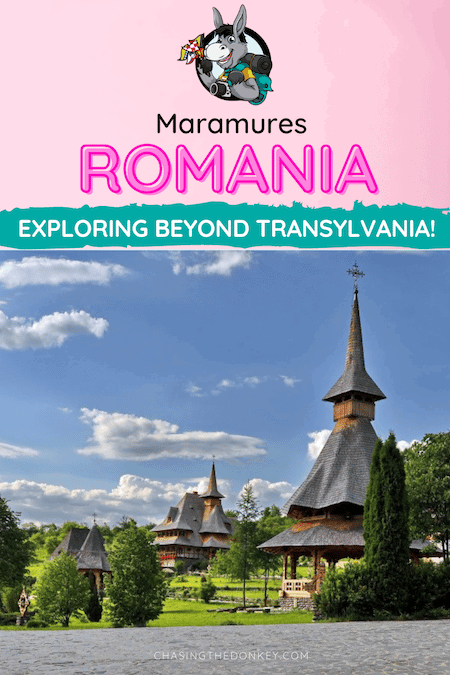
When you say Romania , most people think Transylvania is a major attraction here. Yes, Transylvania has its pluses, and nobody can deny that.
But once you start reading more about Romania and its other regions , you discover that each one of them has something appealing. Maramures, the northern part of Romania, will offer you more than one reason to come here.
It is considered a place with unspoiled nature and well-preserved traditions, a place where people can enjoy food and landscapes as they were 100 years ago.
Before traveling here, it is better to do your homework and learn when is the best time to visit it, how you can get there, where to stay, and what things you can do in Maramures.
Three days are enough to check all the main attractions here. But if you need a relaxing holiday, plan a whole week , and you will have time to savor some walks in the forest, easy hiking, and traditional activities.
Skip Ahead To My Advice Here!
Things To Do In Maramures, Romania

The best thing to do in Maramures is to relax. Enjoy the quiet life here, the nature charging your batteries, and the good, natural food. There are not many corners around Europe so well preserved, which is something Maramures can take pride in.
But besides relaxing, there are other things to do here and places to visit for a complete experience.
1. Visit The Wooden Churches In Maramures
The wooden churches in Maramures are known for their impressive architecture and old history. Even though almost every village has a wooden church (more than 100 wooden churches in the region), only 8 are UNESCO heritage, and some were built 400 years ago.
These eight churches are tall and narrow and were built using a specific technique to combine wood. Not all of them can receive visitors daily, so it is good to know which one to choose because getting to them takes some time. I recommend you visit the Barsana Monastery and the wooden church in Desesti.
Barsana Wooden Church
The most visited wooden church is the Barsana monastery (comuna Barsana, nr. 6, Romania) . It was built at the beginning of the 18 th century with oak wood and had a very tall bell tower (around 57 meters). It has an interesting story because it was moved twice from the original place it was built. Around 1806, it was moved to where it can be found today.
Local painters painted it inside; today, it is part of a group of buildings that form the Barsana monastery. You can visit it every Monday to Friday, 8 am – 9 pm.
Desesti Wooden Church
The most accessible wooden church is the one in Desesti, and you can visit it from Baia Mare to Sighetu Marmatiei. It doesn’t have official opening hours, but if you get there and find the door closed, you can contact the person in charge by phone (his phone number is written on the door). The painting inside, very well preserved, illustrates scenes from the Bible (very interesting is the one about the fire in hell and the tortures suffered by the ones getting there).
The other six wooden churches of UNESCO heritage are in Budesti, Ieud, Plopis, Poienile Izei, Rogoz, and Surdesti. If you like these types of monuments, you can visit them all, but plan your trip carefully because not all the roads are accessible, and you will need more than a day to do that.
2. Take A Walk In The Merry Cemetery

Another popular attraction in Maramures is the Merry Cemetery in Sapanta. Once upon a time, there was a man who hated death. That man was Stan Ioan Patras , and he decided to continue Dacia’s lost tradition. This is how the story of this cemetery begins.
The Dacians (Romanians ancestors) believed that death was a happy event because they could meet their major God afterward. Stan Ioan Patras started to design colorful crosses when someone died, and he wrote a short poem on the cross about the life of the defunct. After Stan Ioan Patras died, his disciple continued his work.
Today, almost 800 painted crosses can be found here. The most important ones have a sign on them so they can be easily spotted. This is how the Merry Cemetery was created.
Some of the poems are very interesting (for the whole experience, ask someone to translate them for you), but the overall feeling is still sadness after visiting this place . The creator of the Merry Cemetery is buried here, just in front of the church.
3. Roam Around The Local Villages
The many villages in the Maramures region are very close to one another, so you can easily visit them during your stay. You can choose to walk in a leisurely manner, or you can cycle. There are many places to hire bicycles, so you’ll have no issues.
Seven villages weave through protected areas, covering 88km. All routes are marked, so you’re not going to get lost!
If you prefer to cycle, the Rooster’s Crest Trail and Rooster’s Trail are the most difficult, with the latter covering 22km. The Rails’ Trail is a good option for those who don’t want to break too much of a sweat, covering 20.8km.
4. Discover The History Of Communism At The Memorial Of Suffering In Sighetu Marmatiei
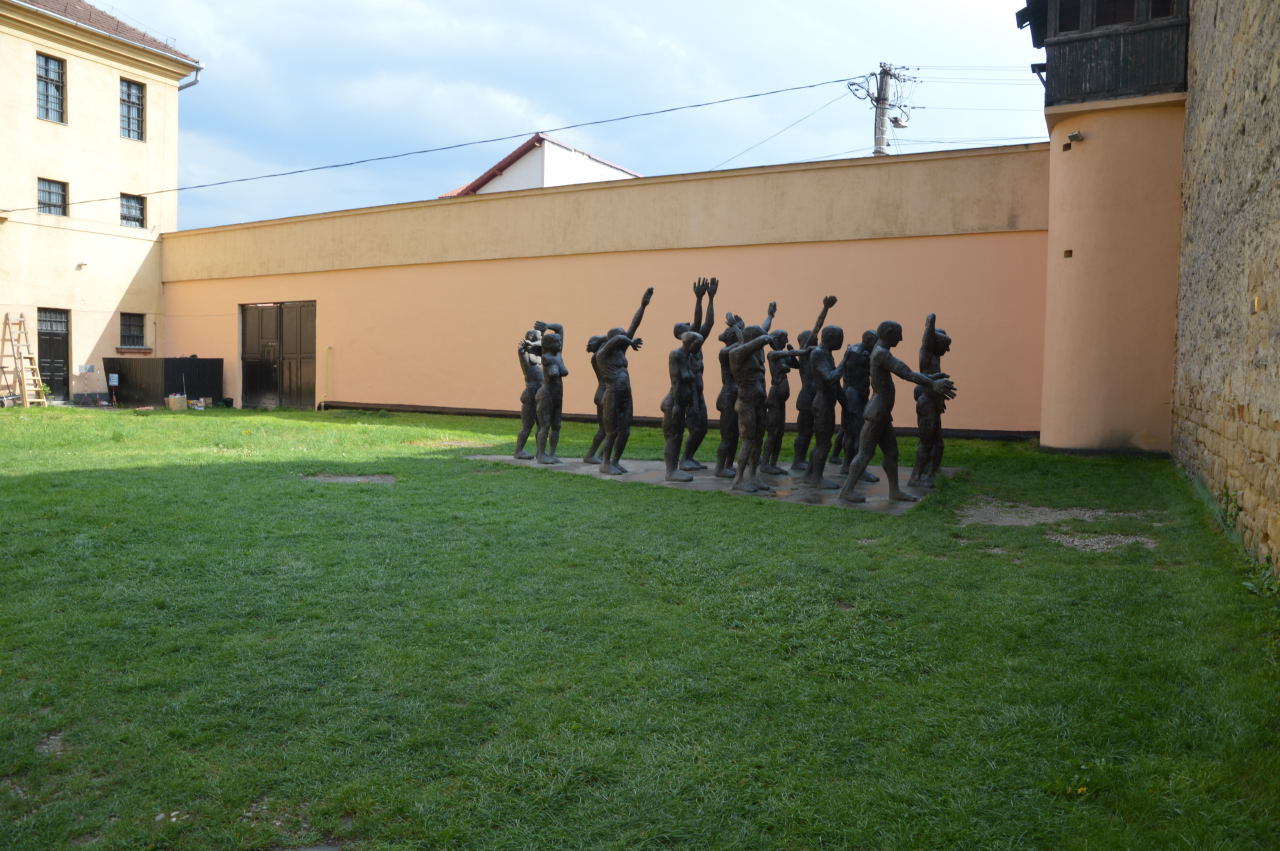
The Memorial to the Victims of Communism and Resistance was opened in the old communist prison in Sighetu Marmatiei. Here, you can learn what communism meant in Romania , how it was established, and what happened to people who fought against it. At the entrance, you can read the same motto written in Auschwitz: “Those who cannot remember the past are condemned to repeat it.” George Santayana.
For those interested in the history of communism, visiting here is a must. All notes are in Romanian , but you can find some printed materials in English. After you visit the prison, go in the backyard to see a sculpture: a group of people pushed by a headless body, representing the repressive system.
5. Sighetu Marmatiei
After checking out the Memorial to the Victims of Communism, the town of Sighetu Marmatiei is worth exploring further.
This town first came to prominence in 1325, and it’s thought to be the first and only town in the whole of Maramures. The town has certainly seen its fair share of history, with communism and Nazi rule scarring the area.
Be sure to check out the Village Museum, where you can learn about this beautiful town’s history.
6. Buy Handcrafted Goods
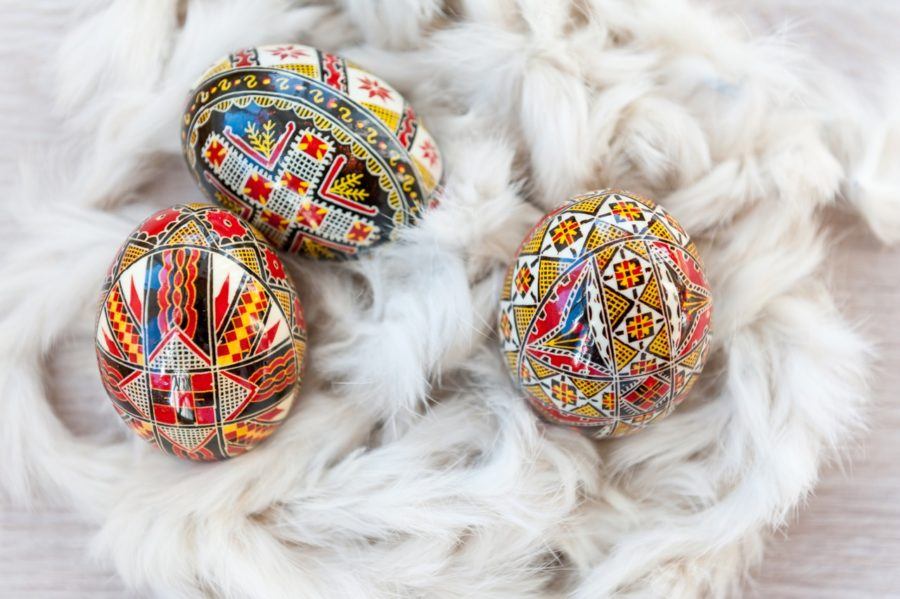
In the many villages, you’ll find craft stores and stalls that sell handmade goods . These are ideal for taking back home as gifts for loved ones. As a few starting points, you’ll find plenty to check out and purchase in Sarbi, Barsana, and Botiza.
Locals are only too happy to let you watch as they go about their work and explain what they’re doing as well as they can. You will probably be mesmerized watching them!
7. Put On Your Hiking Shoes
It’s the local villages you should wander around and the mountains too. You’ll surely need your walking boots , but don’t let that stop you.
The Rodnei Mountains are the second largest national park in the country, and if you’re up for a challenge, you’ll see some fantastic scenery by taking a day’s exercise. Otherwise, Maramuresului Mountains Nature Park will still give you amazing things to see but with less effort.
8. Take A Ride With The Steam Train
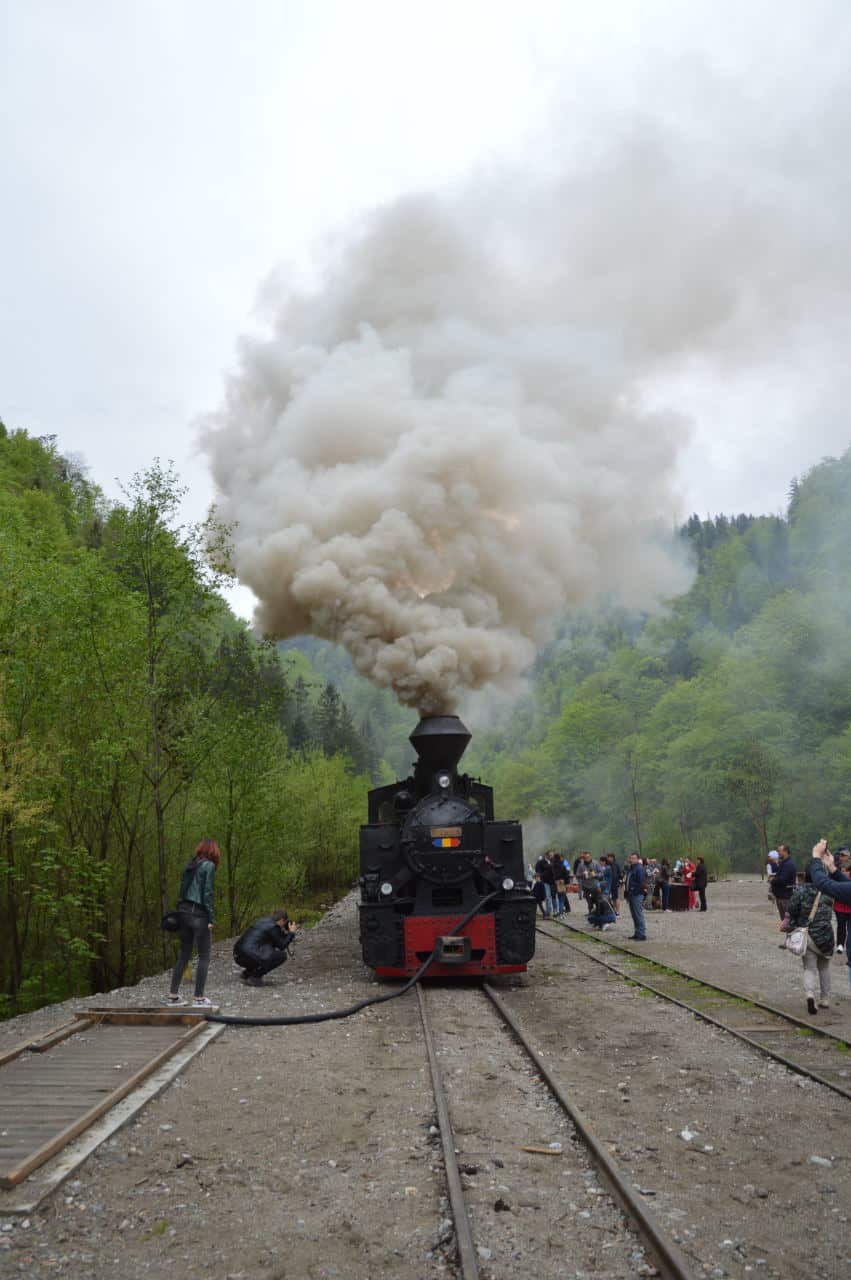
My favorite experience in Maramures is the steam train ride. Every morning, from Spring to Autumn, an old steam train called “Mocanita” departs from Viseu de Sus.
The trip takes around half a day . After 2 hour ride in the wilderness of Northern Romania , you will arrive on a green meadow, where you will stop for another 2 hours.
Here you can visit the small train museum, have a traditional lunch, listen to local music, or lie down and breathe the fresh air – no restaurants, no cars, no phone signal, just a morning in the middle of nature to relax you. The steam train ride is a popular attraction, especially during Summer, so book your ticket in advance.
While you explore this fantastic region, occasionally admire the traditional villages and old houses with big wooden gates and walk in their isolated lanes.
9. Ride A Lift To Horses Waterfall
Head to the Borsa Tourist Complex for a chairlift ride up into the Rodna Mountains. Once at the top of the lift, take a quick 30 minute hike to find Horses Waterfall, a 90 meter high fall flowing in the mountains.
If you are feeling adventurous, continue taking the path until you reach Stiol Lake – a glacier lake that’s absolutely breathtaking.
10. Join A Carpentry Workshop
In Barsana village, head to the carpentry workshop of Teodor Barsan . Not only does Teo make artisan custom wood creations for customers worldwide, but often carpentry workshops are offered onsite for visitors.

11. Try Local Cuisine
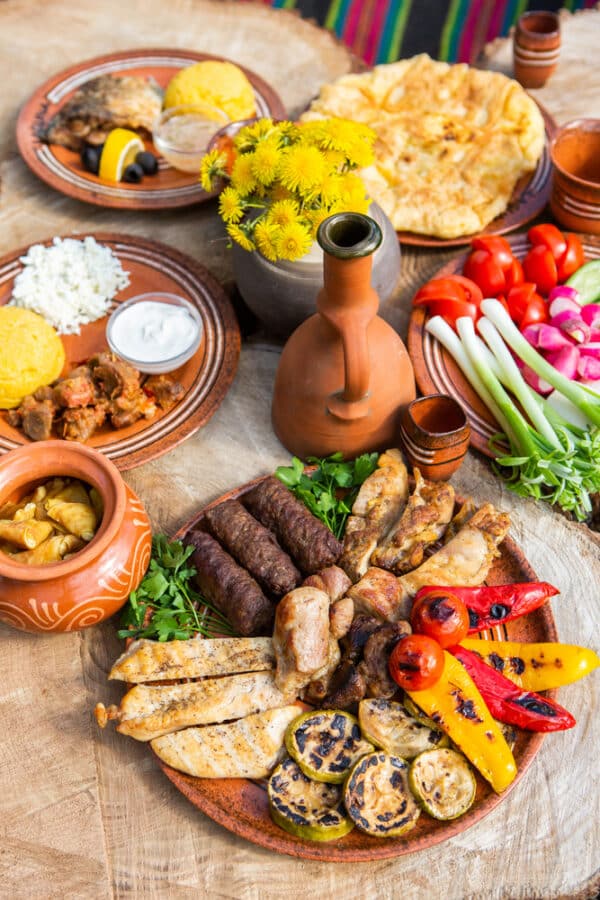
You’ll undoubtedly enjoy filling up on local cuisine , although if you’re on a diet, you’ll probably want to take a day off! Dishes here are famously quite heavy but shouldn’t be missed, many including meat and cheese. Meat eaters will enjoy sampling Caltabos, Slanina, and Toba, while vegetarians have several options , including vegetables cooked in different ways or salads.
For lunch and dinner, consult the menu before choosing a particular restaurant. Some have only traditional dishes, while others include salads and lighter food.
12. Explore The Town Of Baia Mare
Head to the town of Baia Mare one morning. Spend time wandering around the Old Town Square and Stephen’s Tower.
While in town, check out the little known mineralogy museum. Here you can admire over 20,000 mine crystals, rare minerals and gems.
Brands We Use And Trust
When is the best time to visit maramures.
When you decide to visit Maramures, consider that winter is winter (with snow and maybe freezing temperatures), and summer is summer (temperatures around 35 degrees Celsius). And that applies all over Romania .
Spring or autumn is probably a good choice if you are not a big fan of extreme temperatures. These seasons can be rainy but also full of beautiful colors. Autumn is even more colorful than Spring: all shades of red, yellow, orange, and green can be seen! To see the blossom trees and green gardens, book your trip in Spring. During Easter , you will have the chance to see some of this region’s traditions: painted eggs, traditional costumes, and delicious food.
Summer is the holiday season. It may not be as warm here as in a big city, but summer in Romania is hot, and Maramures is no exception! It may be a little more crowded than usual, but only at the main attractions. But it is the perfect time to enjoy nature and mostly stay outside as much as possible! The hills, gardens, and forests will be just yours!
Winter can be tricky here . If you don’t like snow, I don’t recommend winter at all! But if you don’t have a problem with cold weather, Maramures will reward you with fantastic white views. Christmas is another great moment to experience the local traditions.
The only thing with winter is that if you decide to come in January or February, some attractions are closed, or their winter schedule is short. Once you have determined the best time to visit this exciting place, it’s time to choose how to get there.
How To Get To Maramures

Before planning your trip to Maramures, it is good to know that you will need a car to explore this area. Whether renting one, coming on your own, or booking a guided trip , a car is necessary to reach the main attractions. Maybe that is why the region is unspoiled: it is not easily accessible.
Getting To Maramures By Plane
The closest airport is the one in Baia Mare (the central city of the region), named “Maramures Airport,” but you won’t find international flights that land here (yet). Another airport is the one in Cluj Napoca . It will take you around half a day to get from Cluj Napoca to Maramures, but the airport in Cluj is not very big either.
The two options with enough international flights are Bucuresti, Henri Coanda, or Budapest . Of course, you will need a day by car to get from Bucharest /Budapest to Baia Mare or another flight.
But most tourists stay in Bucharest and tour Romania, including Transylvania and Maramures.
Getting To Maramures By Train
Another option is to take the train from Bucharest (or any other major city in Romania) to Baia Mare. The ride takes around 13 hours, which is not your best option. But if you choose it, you can book your train tickets online .
Getting To Maramures By Bus
If you land in Bucharest, you can also take the bus, and after 13 hours, you will arrive at Baia Mare. The bus is also an option to explore the region for those who don’t like driving and do not want a guided tour.
It will only take you near the main attractions, but the bus schedule won’t allow you to see as many items as possible by car. Also, some attractions are not reachable by bus. It would be best to consider all these conditions before deciding the best way to travel to Maramures.
After establishing how to get there, you must choose where to stay in Maramures.
Move This Adventure To Your Inbox & Get An Instant Freebie

No spam. Unsubscribe at any time.
Where To Stay In Maramures
An excellent base to explore the region is Sighetu Marmatiei. Sighetu Marmatiei is a small town in the north, and from here, all the tourist attractions are easy to reach.
You can find good hotels and B&Bs. If you want to stay in the countryside, choose one of the many pensions. Most are traditionally decorated, but you still have some options if you prefer luxury accommodation. The best part about these pensions is that they have massive gardens. You can lie on the grass and listen to nature’s sounds all day.
Not all of them offer breakfast, and not all of them have restaurants. If you want to start your day early in the morning, choose accommodation with breakfast included.
Nobody who visits Maramures comes back disappointed. Nobody.
Discover this land where it seems like time stood still.
People are astonished by its beauty and thrilled that it seems so isolated and still. In a world full of gadgets, speed, and big cities, visiting here is like a breath of fresh air, a trip back in time.
What are the recommended sights in Maramureș, North Romania?
The Bârsana Monastery, local villages, particularly Sârbi, traditional festivals in Maramureș, the traditional water-actioned mechanical systems in the Sârbi, the historical sites in the Breb village, the Merry Cemetery in Sapânța, the Peri Monastery, the Sighet Village Museum, and the Horses Waterfall.
What can I do at the Bârsana Monastery?
Visitors can admire the beautiful architecture and gardens that the monastery has to offer.
What activities are available in local villages like Sârbi village?
You can experience authentic cultural interactions with artisans and locals.
What are the annual traditional festivals in Maramureș?
Annual traditional festivals and celebrations are usually associated with important dates in the Orthodox calendar and often involve traditional costumes, dance, and music.
What unique tradition can be found in Sârbi village?
The village is known for maintaining traditional water-actioned mechanical systems.
What attractions can be found in Breb village?
Historical houses tied to Prince Charles and the old Archangels Michael and Gabriel church are key attractions.
What is special about the Merry Cemetery in Sapânța and the Peri Monastery?
The Merry Cemetery is known for its colorful and descriptive tombstones, while the Peri Monastery is known for being the tallest wooden church construction in Europe.
What can be seen at the Sighet Village Museum?
The museum displays traditional Maramureș wooden houses and farm buildings.
What is the Horse Waterfall?
It is a natural attraction accessible via a chairlift and a short hike, known for its stunning landscape.
Are you ready to take this trip? What will be on your things to do in Maramures list?
- Romanian Food
- What To See When You Visit Romania
- Things To Do In Romania
- Bucharest Tours
- Things To Do In Brasov, Transylvania
- Where To Stay In Brasov
Comments (2)
I would like to plan a trip to my mom’s birthplace. She was born in what was Tisa Vereshmort, in Maramures, Romania. I can’t find this on a map. her home had a well on her property. She called her home Mikif before she left in 1940. Any ideas or tips are appreciated. I tried googling the area, other than an old map nothing comes up for me.
Kudos for giving Maramures, Romania some well-deserved love in your blog!
Leave a Reply Cancel reply
Your email address will not be published. Required fields are marked *
Save my name, email, and website in this browser for the next time I comment.
This site uses Akismet to reduce spam. Learn how your comment data is processed .
Subscribe To Unlock Your FREE Customizable Travel Packing List & All Our Best Tips!
Unlock Your FREE Customizable Travel Packing List!
Subscribe Now For Instant Access To Stress-Free Packing
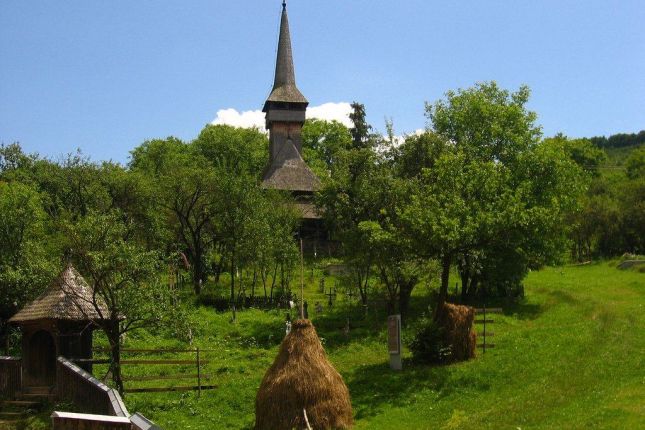
Visit Maramures: A Timeless Journey | 9 Things to Do & Places to Visit
The region of Maramures in North-West Romania is famous for many reasons among Romanians - but most foreign travelers don’t know them and miss out on this hidden gem.
In short, it’s the most representative for Romanian culture because our folk traditions and rural way of life are well preserved by proud and hospitable locals.
Even if Transylvania is more popular - Maramures is more authentic and alive. It’s a land where time slows down. Locals respect ancient traditions passed down from generation to generation and live in a deep communion with nature’s rhythm.
It's a place where wood, transformed into art by gifted artisans, is used in everyday life. Where the folk costumes people proudly wear - and often - bring color and joy to every event.
Where the famous Wooden Churches of Maramures aren't just architectural marvels. They're the beating heart of tradition, echoing the rich heritage of the Romanian village and Orthodox faith.
In this article we will cover:
- the rich tapestry of Maramureș with its rich cultural heritage and cherished traditions
- the many tourist attractions and things to do
- practical advice on how to visit the region
By the end I hope you’ll see why it’s worth including it in your itinerary when you visit Romania. So, let’s get started, shall we?
Table of contents
Why is Maramures special?
How to plan a trip to maramures, tourist attractions in maramures, 1. admire the wooden churches of maramures, 2. visit barsana monastery complex, 3. make quick stops at shrines by the road, 4. wood carving: gates, utensils and decorations, 5. the merry cemetery of săpânța, 6. communist memorial in sighetu marmației, 7. go on a ride on the mocănița steam train, 8. explore traditional villages and natural beauty, 9. dive into romanian food, drinks and hospitality.
This video captures everything that makes Maramures special
Maramureș stands out as the region in Romania where traditions are most faithfully preserved. This was possible thanks to its geographical characteristics: a mix of fertile lands with many valleys, dense woodlands and rolling hills perfect for pasture, all protected by tall mountains.
Accessible only by car, 150 km (or 3h) away from the nearest big city, Cluj-Napoca, and 600 km (9h) away from the capital, Bucharest, Maramures was protected from the historical and political drama of big cities, or the iron grip of the communist regime, which Romania’s history saw plenty of.
Over centuries, tightly-knit communities were formed between villages in the region. Locals were able to keep their ancient traditions and way of life undisturbed until recent decades, thus creating a colorful, loud and friendly scene for ‘unaware’ visitors, especially if they happened to attend local celebrations (almost every Sunday).
Up until the Great Union of 1918 when greater Transylvania joined Romania (at that time Wallachia and Moldova), the Romanian language and Orthodox religion were banned in an attempt to suppress Romanian national identity.
So the modest wooden wooden churches played an important role in preserving local customs, culture and community spirit. That’s why even today every Sunday morning locals wear their best folk costumes, gather the family and head for the church.
- Local tip: if you’re planning to visit Maramures try to be there on Sunday; a guide can help you meet locals and even participate in the local gatherings or small celebrations that typically happen after church service
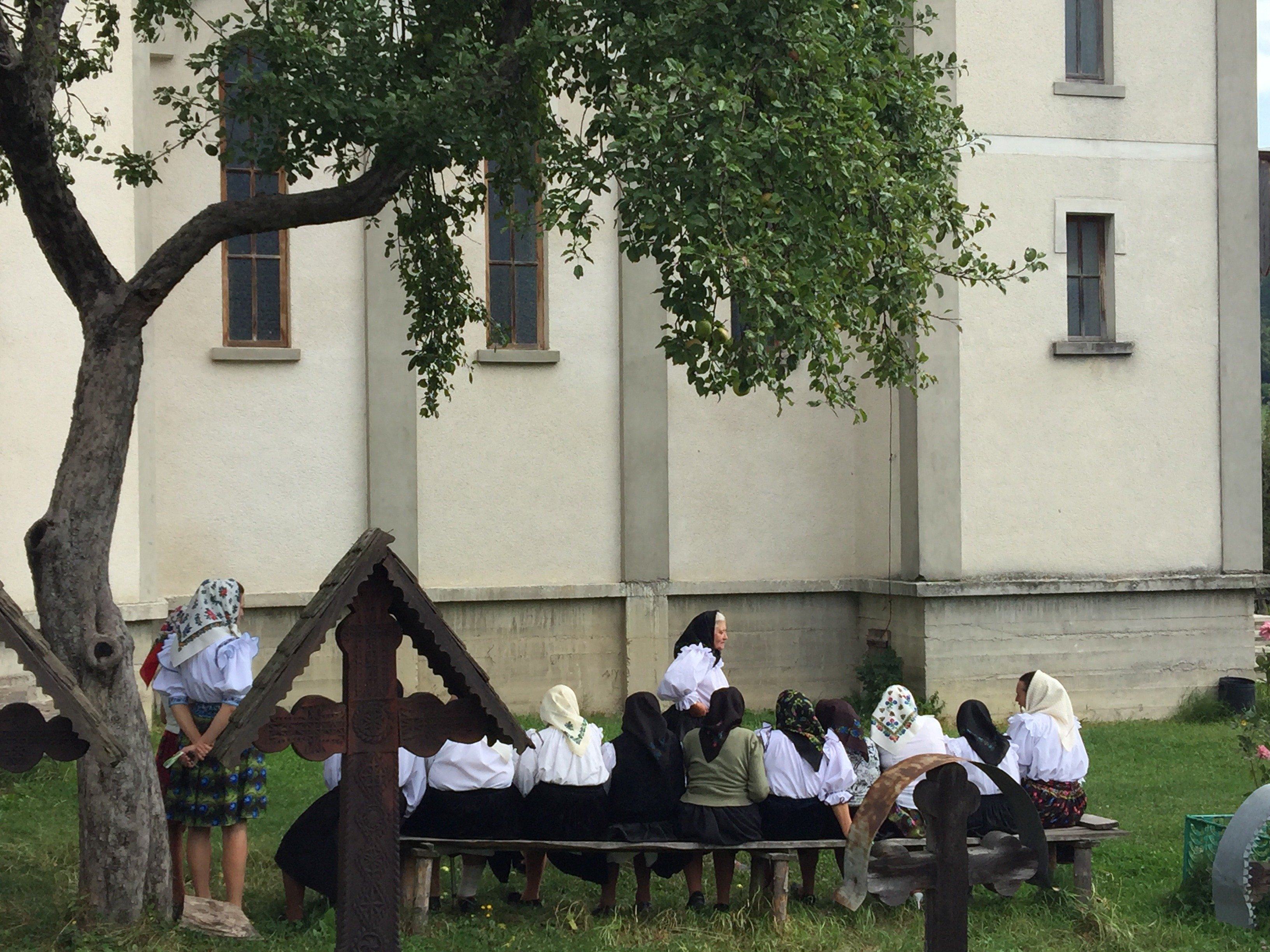
While visiting the region you can spontaneously come across a hora (a folk dance performed in a circle) with folk singers calling locals to join the dance. Don’t worry - it’s easy to learn and everyone is welcomed!
Traditional crafts are still part of everyday life, especially wood carving and weaving of intricate folk costumes and tapestry decorations. You’ll see finely-carved, huge wooden gates at every household. The bigger and more intricate, the more status the family had. With the right connection, you may even visit an artisan’s workshop.
Local traditions and celebrations are at their best during the Romanian Christmas and Easter holidays, the most important in the Orthodox calendar. That’s when locals bring out their best costumes, food and good spirits while fascinating rituals can be observed. Because it was so far away from Bucharest, Maramureș was largely ignored by politicians in Bucharest. Due to this, the wooden churches so unique for this region weren't destroyed, unlike the churches in other parts of the country targeted by dictator Nicolae Ceausescu for whom religious practice was against socialist values.
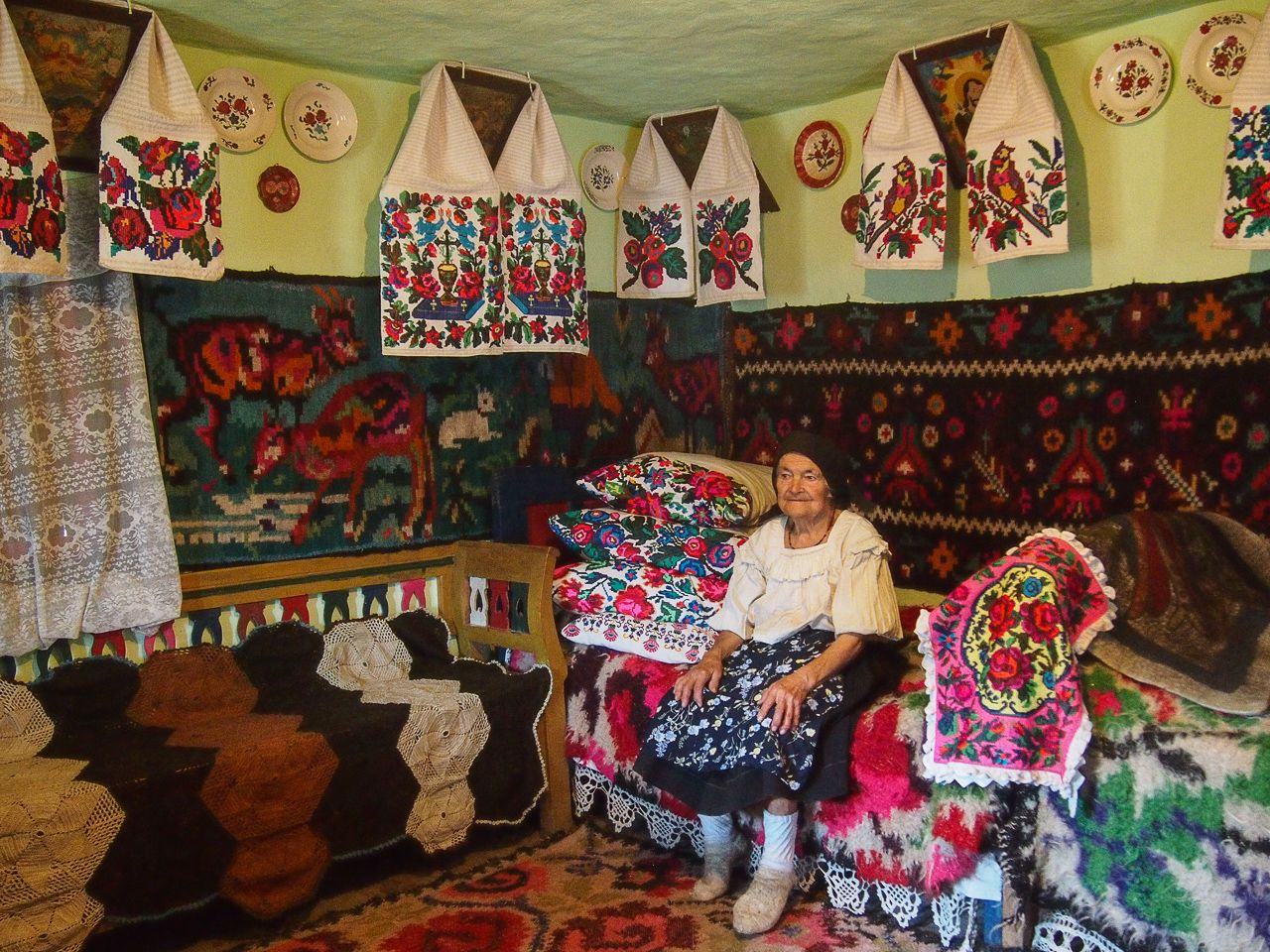
Add to this the locals’ natural hospitality and delicious food with home-grown ingredients, and you already have the premises of a perfect holiday. Traditions and vernacular architecture are one of the things I like the most when traveling to Maramureș. It is a place where you can witness how life was a few centuries ago before industrialisation, consumerism and the internet.
I believe this is one of the few authentic peasant cultures left in Europe that fortunately continues to thrive in its purest form. And that’s the #1 reason you should consider visiting it.
Now for some practical matters. As you’ll see, visiting a remote region that is mostly rural and not used to foreign tourists is not exactly easy :)
View this post on Instagram A post shared by Visit Maramures - Romania (@visitmaramures.ro)
- Best time to visit Maramures
Come to Maramureș between April and October, when the weather is warm and nature is in full bloom. To be honest, this is the best time to visit Romania for pretty much anything!
Just know that if you’re visiting Romania in winter snow will make everything special and the Christmas traditions are wonderful - but also more challenging. Tourist sights have shorter schedules, public, open-air celebrations are rare and, of course, you need to be dressed well because it can get very cold with heavy snow.
On Easter and Christmas, the region of Maramures comes alive and there are lots of local traditions to witness. However, these dates are very busy and you should book your stay at least two months in advance.
- How to get to Maramureș
The best way to get to Maramureș is by car. Even if villages well connected by road, there are no local buses traveling between them and the few that do are not convenient as they have irregular schedules. I wouldn't rely on them even if I'm a local!
Keep in mind that Cluj Napoca is 3h away by car, whereas Bucharest is 9h away. So if you land in Romania's capital and want to visit Maramures, I recommend flying to Cluj Napoca, Satu Mare or Baia Mare.
From there, the easiest option is to go on a private tour or rent a car. To learn more about the public transportation in Romania and how to get around efficiently, read our complete guide on this topic. However, as I've said, locals don’t speak English and tourism in the region is very local. This means public events and artisans’ homes are not advertised in English or online, and tourist signs are mostly in Romanian. So other than visiting landmarks in the region on your own, you won’t see much and miss out on discovering its true charm...
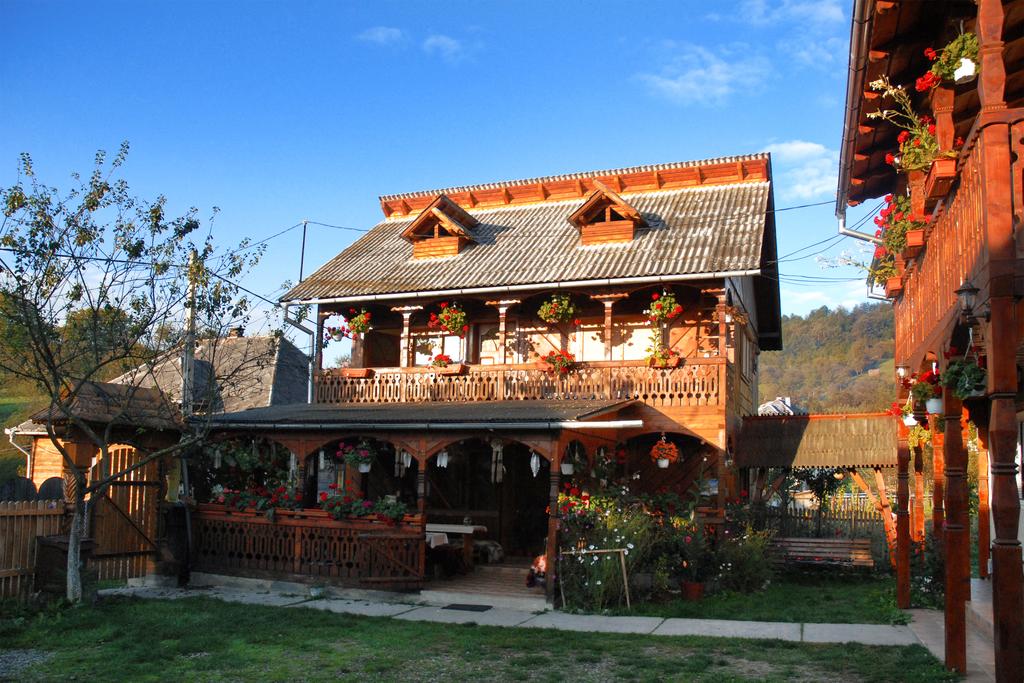
- Where to stay
In Maramures there are no hotels and the most you’ll find are guesthouses, a type of B&B called Pensiune or Casa. You'll find plenty of these on Airbnb or booking.com, but some local Romanian websites could help as well such as lapensiuni.ro or ruralturism.ro .
These rustic accommodations are quite basic so lower your expectations in terms of comfort and appearances.
On the bright side, you’ll be forced to experience rural life and most of these typically have nice courtyards.
Because there are no restaurants in the villages and even if there are, they don’t operate regularly - we recommend booking a guesthouse that serves meals on-site. You’ll have at least a good and hearty breakfast and dinner.
In terms of which village to stay in, I would go for Desesti, Breb, Botiza, Viseul de Sus or Viseul de Jos.
Our guides know several authentic family-owned guesthouses but their value-for-money ratio fluctuates depending on the family's plans and availability for each year. So I don't want to recommend any that would turn out to be a bad choice. Most locals do tourism because of their natural hospitality, not necessarily as their primary business. ***
You will need at least 2 full days to properly visit the region. Main tourist sights are spread across small villages and you need about 1h to travel between them, even if they seem very close on the map. And even then don't expect parking in front of a wooden church.
I know this can be frustrating when you have limited time for your trip, but this is why this region is ideal for slow travel. In Maramureș, you visit the sights, go on village walks and spend time with locals.
This is not the place for fast tourism and those on a rush to see as much as possible will be disappointed because that's not what makes this region so attractive.
To conclude, if you don't have enough time during your holiday in Romania, or if this is your first time in our country and want to see the major sights first, then I would recommend either creating an itinerary with 2-3 days in the region OR leaving Maramures for your next visit to Romania.
As these lands were once part of the Hungarian, Habsburg and later Austro-Hungarian Empire, Catholic religion was considered the official one. So the Romanian Orthodox population wasn’t allowed to build stone and brick churches that would survive the test of time.
So local builders, skilled in woodcrafts, switched to a special technique of using wood to build spiritual places of service. So steepled wooden churches with high, slender, and impressive bell towers started appearing in the region and these were quickly decorated to express and preserve local traditions and culture.
The churches are special not only for their architecture marked by high wooden towers and folk decorations, but also for their naive biblical frescoes and representations of traditional rural life.
This is in contrast with the artistic and intricately Painted Churches from the Bucovina region , another set of famous UNESCO landmarks in our country.
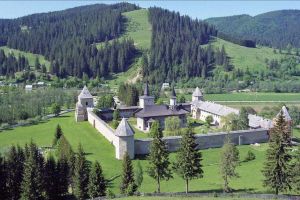
5-Day Complete Tour of Traditional Maramures & Bucovina
Start from: Cluj-Napoca
Similar with other famous Romanian churches , they became the guardians of Romanian national identity.
These are found in the villages of Bârsana, Desești, Budești, Ieud, Plopiș, Poienile Izei, Rogoz, and Surdești. Most of them are closed during the day but some churches post a telephone number on the main gate and you’ll have to locate the church's key holder to let you in.
At this point, we highlight the importance of having a local guide who speaks Romanian and knows the regular visiting hours, how to find the doorkeeper and to explain what you're seeing. Briefly, here's what makes the UNESCO wooden churches in Maramureș special - and we also included a few more than are not included on the list but are of significant cultural value:
- Surdești church built in 1721 features a 54-meter-high steeple and wall paintings of Christ’s Passion and the Apocalypse
- Desești church built in 1770 has interior paintings representing Sodom and Gomorrah
- the church in Plopiș impresses with another towering steeple and well-preserved interior paintings of Christ’s Passion
- the church in Poienile Izei has dramatic frescoes of hell, depicting torments inflicted by the devil on sinners
- Ieud church hosts one of the largest collections of icons on glass in Maramureș
- Budești church dating from 1643 features four small turrets around the main steep bell tower as well as 18th-century glass icons with local naive paintings
- the church in Săcălășeni is the oldest in Maramureș dating from 1442
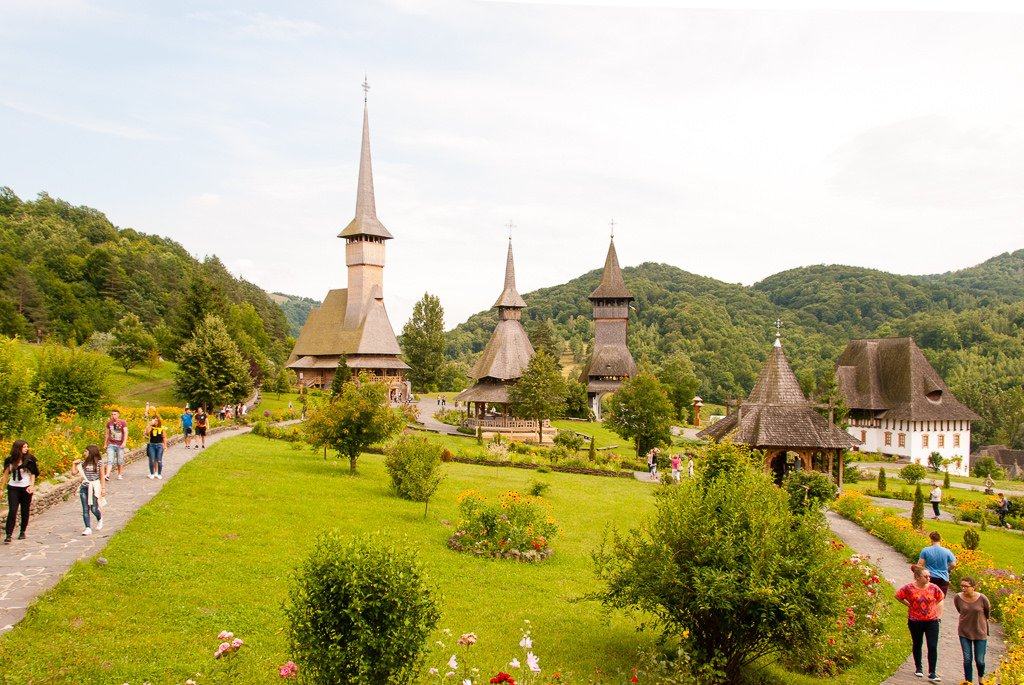
Even though it’s a new construction, the Bârsana Monastery Complex includes ten buildings surrounding a wooden church all of them built in 1993 with all the typical markings of Maramures. The buildings have paintings and impressive glass icons made by local artisans.
The complex is a training ground for priests and there are regular ceremonies and events on its grounds - so be respectful.
Its alleys are beautifully decorated and the best time to visit them is during the warm season when all the flowers are in full bloom.
As you travel through the region you may notice fascinating structures by the road or up on hills. These are called troiță and are in fact small shrines where locals stop to pray, make blessings or practice gratitude. This is very typical for the Orthodox community in these parts, but less so across Romania.
All of them are made out of wood and are intricately carved, many with biblical motives. So if you see them - stop and get close to admire them. You could also slow down, take a breath and connect with the divine, whatever that means to you, since you'll most likely be faced with beautiful views.
Maramureș features vast hills and rich forests as far as you can see. This is the main reason why wood exploitation is a centuries-old occupation in the region. The mountainous countryside is dotted with wooden cottages and ramshackle farm buildings creating a special atmosphere.
All local farmhouses have wooden gates and, besides the wooden churches, this is another unique architectural feature of the Maramureș region.
Originally, the wood gates were built to protect households from evil spirits. They represented a symbolic barrier between the safe interior (protected by a natural element) and the unknown outside world. Among the common ornamental motifs on these gates you'll find the tree of life, snakes, birds as well as human faces protecting from spirits.
However, in time, the wooden gates also became a sign of social status. The bigger and more intricate a gate is, the wealthier the inhabitants are. You’ll find elaborately crafted - and huge - gates in the villages of Desești, Vadu Izei, Mara, Sârbi, and Bârsana.
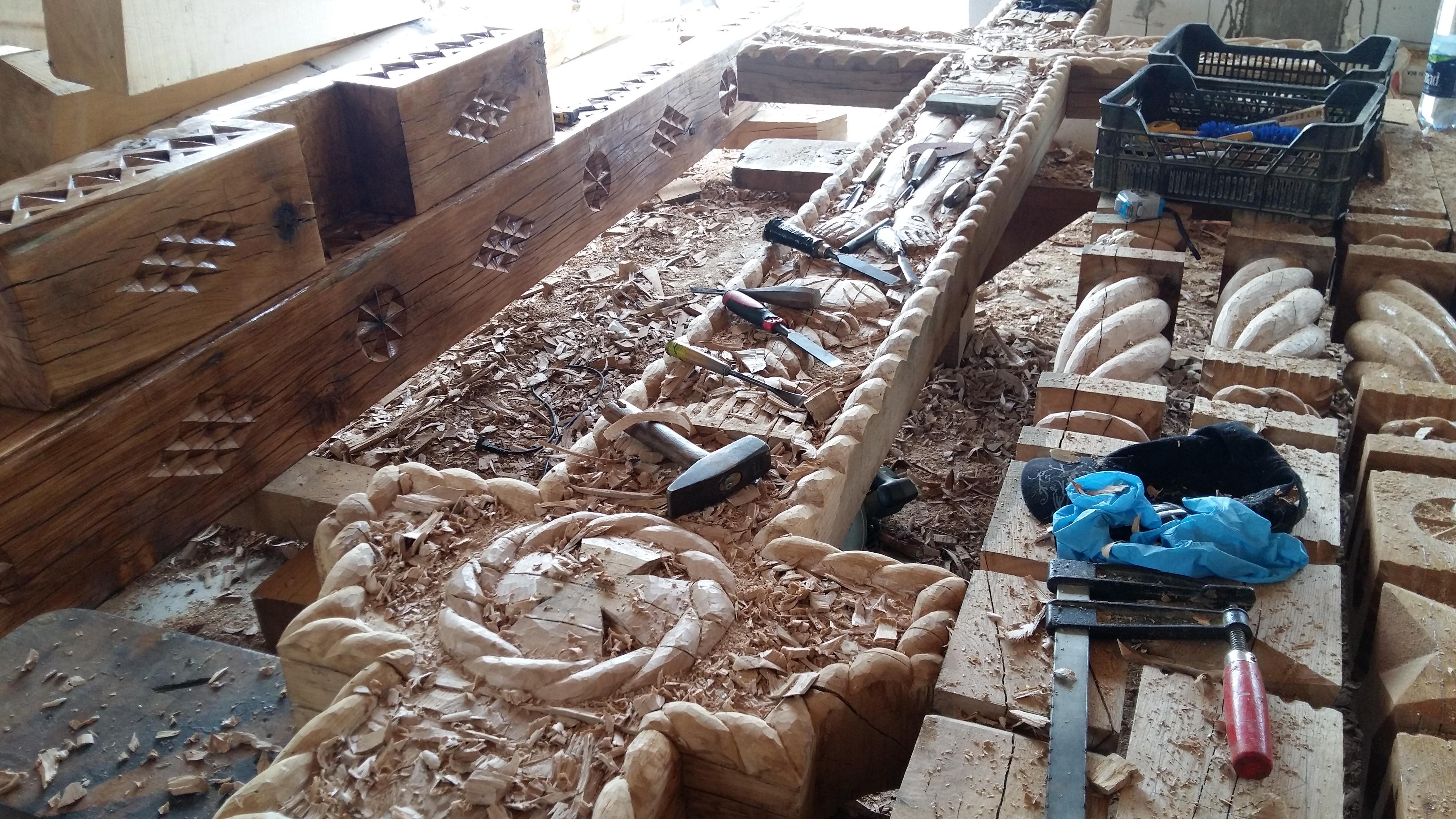
Wood carvers learned their craft and techniques from generation to generation, but sadly the number of artisans has been steadily declining in recent years as younger generations take up other 'occupations.' However, there are still local workshops where artisans are happy to welcome visitors but most are not signposted or advertised.
One of our guides, a native of the region, can take you on such visits so you can see them in action. You may find one of the best Romanian souvenirs here - useful too - such as wooden utensils, cookware, homeware or decorations with traditional motifs.
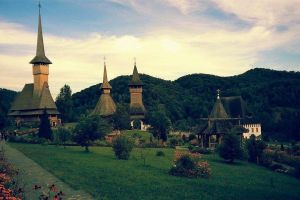
2 or 3 Days in Maramures: Wooden Churches, Traditions & Village Life
You’ll be amazed at how creative these craftsmen are and what you can find there. Moreover, it's always a good idea to support small businesses and help the local community keep ancient crafts alive.
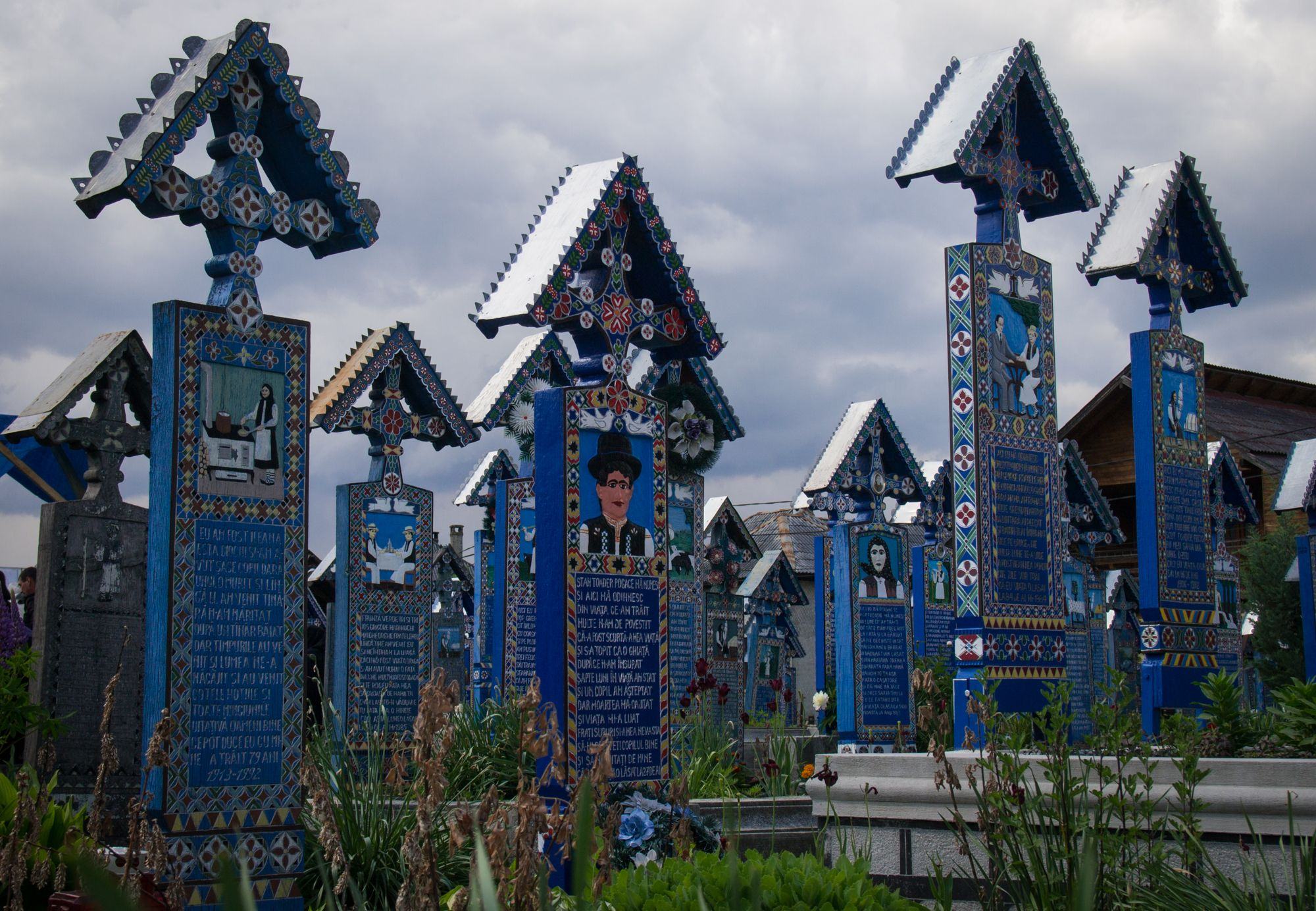
The Dacians (Romanians’ ancestors) believed death was a happy event. Dacian tribes settled here around 1000 BC and they were never conquered by the Romans because of the wild mountains protecting the Maramureș region. This is why some Dacian beliefs and rituals have survived and been adapted over time.
Stan Ioan Pătraș (a wood sculptor) continued this ancestral tradition and brought it to a state of unique art. He created the first ‘happy’ crosses in 1935. The crosses marked the graves in the old church cemetery in Săpânța village and, on each cross, he inscribed a witty epitaph to the deceased.
These included humorous narratives from the dead’s life, illustrating a wealth of traditional occupations. For example, typical scenes include shepherds with their sheep, women cooking or baking bread, weavers working at their looms, etc. Ioan Pătraș even carved and painted his own cross, which can be seen in the cemetery.
The Merry Cemetery looks like a colorful forest of painted wooden grave markers. The crosses in the cemetery are all unique and original.
View this post on Instagram A post shared by Silvia Cinque (@silcinq)
The sleepy town of Sighetu Marmatiei is Romania’s most northern town, featuring a rural charm and a central square edged by churches of all denominations.
You’ll be surprised to discover this small town has a rich history and a multiethnic character. I love walking its quaint streets because it’s so unexpected with all its various monuments and landmarks.
But despite the calm atmosphere of today, there's a grim legacy hanging in the air. When the Romanian communist regime came to power in 1947, this is where one of the regime's most brutal prisons was established.
Politicians, intellectuals, priests and anyone who opposed the new political leadership were imprisoned here, far away from the capital Bucharest. About 180 major Romanian figures were held here between 1948 and 1952, out of which 51 died due to the harsh conditions.
After the fall of the communist regime, the prison was refurbished and became the Communist Memorial in Sighetu Marmației to commemorate the suffering and the memory of those lost here. This is one of the best Romanian museums to visit if you want to understand what life was like during those times. Sighet was also an important Jewish settlement until 1944 when many Jews were sent to Auschwitz. Elie Wiesel was a famous Romanian writer of Jewish origin who won the Nobel Peace Prize in 1986.
You can visit his memorial house in Sighetu Marmatiei which traces the writer’s life and work as well as the history of Jews in Maramureș. There’s also a Jewish cemetery and a Sephardic synagogue in town.
Near Vișeul de Sus Vaser Valley is one of the wildest in Maramureș. The town’s main road inevitably leads towards the train station at the edge of the forest where you can embark on a genuine adventure into the wild on the steam train called Mocănița.
It started service in 1932 and is one of Europe’s last steam-powered forest train still in service. It travels at a speed of 30-40 km/h about 22 kilometers on a 12-gauge track, the original ones meant for 'slim' trains, winding through forested crags difficult to access otherwise.
It was originally used to transport logs from the wood exploitation in the hills but now it will take you on a wonderful journey through the picturesque Vaser Valley, making several stops in picturesque areas . Kids love it!
Keep in mind that the train tickets are in high demand and you need to book in advance. Check the official website for more info.
I remember the journey I took with my father on the Mocănița. On the return trip, the train stopped for one hour in the middle of the wild and we could admire the mountainous scenery until the engine was refueled again. I told about how you’ll travel back in time while visiting Maramureș!
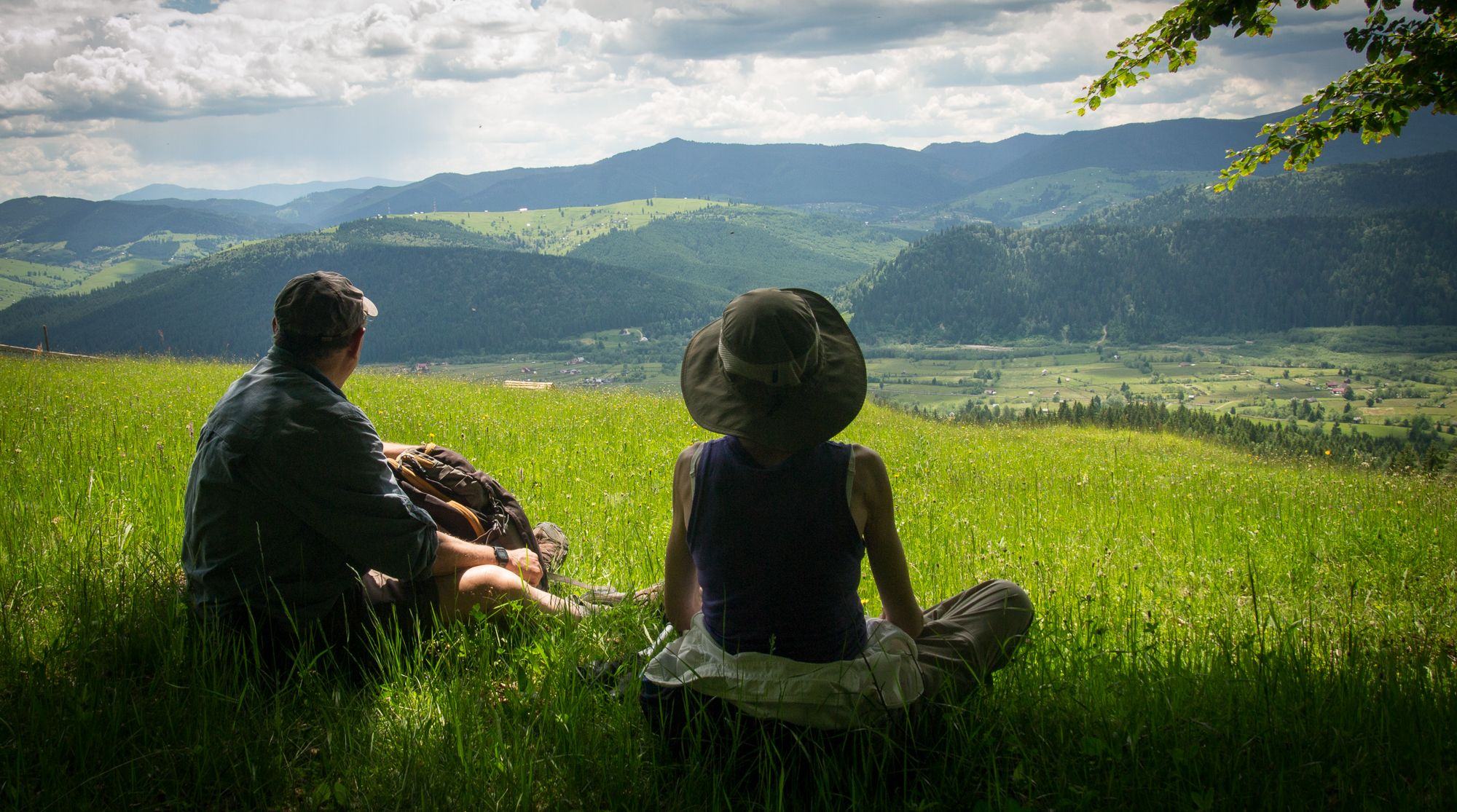
Rolling hills and wildflowers are the typical scenery you’ll see while traveling from one village to another. Countryside roads and hundreds of other footpaths link the most hidden hamlets in Maramureș.
After hours of traveling, you can reach remote settlements in the less expected places. It’s like a gift that you keep opening and there’s always a small jewel to discover.
The isolated Iza Valley sends you back in time with its rustic homestays. Breb is maybe the most authentic folk village in Maramureș as here you can immerse traditional lifestyle at its best.
The village has ancient wooden houses and a 16th-century old wooden church. Many craftsmen live here, such as the woodcarver Patru Pop.
Botiza is another traditional village, with authentic homestays and inhabitants flocking to the church on Sunday mornings. Ieud is packed with local wood houses and of course, the unmissable wooden church.
But let’s not forget the natural beauty too! Hiking in the Rodnei Mountains offers multiple options. You can summit Mount Pietrosul Rodnei (2,305m – the highest in the region) from Borșa mountain resort and then backtrack. Or you can continue along the rooster crest of the mountain range.
Trekking the Rodnei Ridge is one of the most challenging experiences in the Carpathian Mountains . You’ll need camping gear and supplies as there’s no place to stay in this wilderness. A good physical condition and hiking experience for this multi-day trek is required too, unless you go with one of our hiking guides who can take care of everything.
If you follow the ridge marked with a red-and-white stripe, you will have expansive views, sleep by glacial lakes, and under the starry sky. But if the full trail is too much for you, then a day trip to the Horses’ Waterfall (90 meters high!) close to Borsa is a good option.
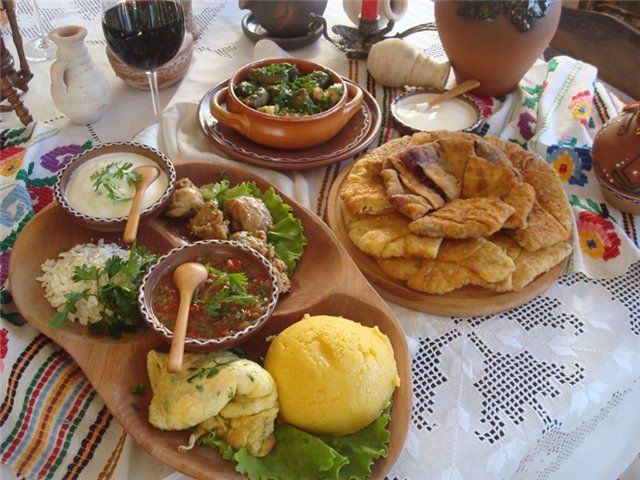
We talked a lot about architecture, pristine nature, and traditional customs. But let’s not forget the delicious and hearty Romanian food Maramureș is so famous for.
Small-scale agriculture and food production is still the main occupation for many locals and selling their produce at food markets or by the side of the street is their main source of income. So, naturally, they have delicious home-grown vegetables and fruits and a variety of jams, pickles, honey and more.
And when these are cooked in traditional - yet unpretentious - meals such as soups (ciorbă) slow cooked stews (tochitura) or the classics sarmale - the taste will be memorable. Many Romanians swear by the delicious taste of these in comparison to the same ones in big cities.
Horinca is obtained from a specific selection of ripe plums, double distilled in copper alembic stills, and aged in an oak cask. On our tours you can see the process in action and even participate in a horinca tasting - if you dare! *** So, now you have all the basics about Maramureș. If you want to research the region more in-depth, visit the official website of Maramureș so you can start planning your trip and make sure you add as many important sights as possible to your list.
Also, let us know if there’s anything we can do to help make your trip to Maramureș unforgettable.
Your Romanian Friend, Iuliana
Places to visit
- City Travel Guides (5)
- All Tourist Attractions (22)
- Tourist Regions (5)
Related tours
2-day best of maramures tour, complete tour of maramures & bucovina.
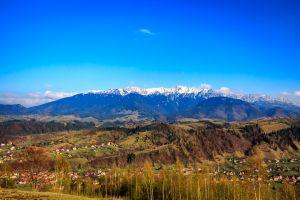
10-Day Best of Romania Group Tour
Start from: Bucharest
Check our tours
- By category

4 times a year we prepare a newsletter with local stories, places and our special insights about Romanian culture and local life that will inspire you to visit our country and have an authentic local experience. Would you like to get it?
Follow Romanian Friend on:
#romanianfriend.

- Bucharest tours
- Day trips from Bucharest
- Transylvania tours
- Romania tours
- Romania and Bulgaria tours
- Self-guided tours
- Virtual tours in Romania
- Tailor-made tours
- Corporate events & business travel
- DMC in Romania
- Reviews from our clients
- How do I pay?
- Romania Travel Blog
8 Remarkable Things To Do In Maramures, Romania
- August 30, 2024
There are some famous things to do in Maramures, but also attractions that not every turist is aware of. And this is something common because Maramures is itself a secret gem.
If you’ve ever wondered how it is to explore the beautiful wilderness of Romania or how it is to experience the actual traditional life of the people, then you should visit Maramures. Situated in the northern part of Romania , this region it’s very well known for its welcoming people, amazing landscapes, and authentic wood architecture.
Maramures is a wonderful place to visit if you want to enjoy an active holiday. The best ways to visit this county are walking, cycling, and hiking. You’ll find dozens of hidden gems to see and plenty of new experiences to try every day. Ready to discover what this region has to offer? Let’s dive in.
Best things To Do In Maramures
Admire nature on a steam train ride: mocanita.
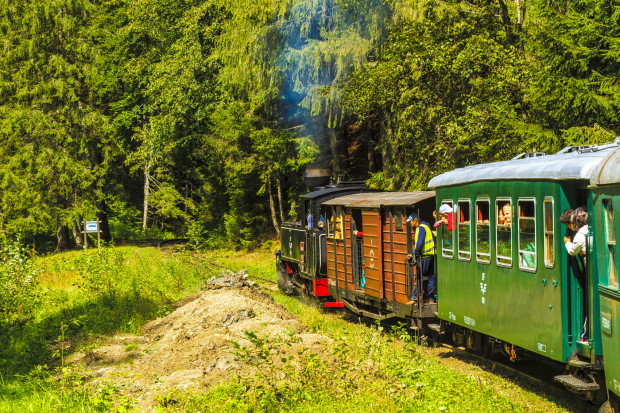
This is probably the most famous attraction in the region. Known as the only functional forestry steam train in Europe, Mocanita will definitely give you a fairytale experience. The train leaves from the little town Viseu de Sus and travels deep into the charming Vaser Valley, crossing the Maramures Mountains Natural Park.
The view is breathtaking as the train crosses green forests, steep rocks, and clear creeks. The ride takes 6 to 7 hours, including a few stops, so you can take as many pictures as you like. The last stop, in Paltin, takes an hour. On an observation deck, you should explore the surroundings, enjoy lunch, or admire magical landscapes.
Discover the traditional wooden churches
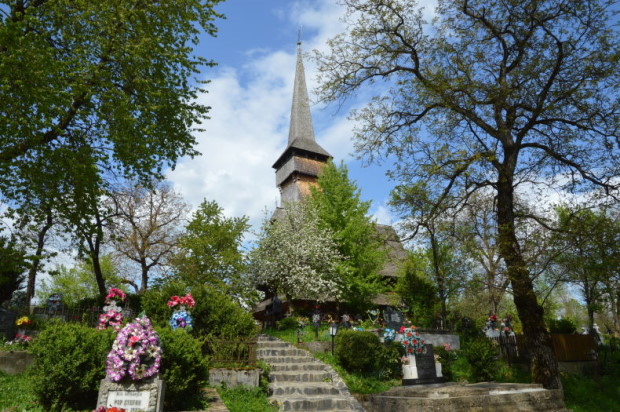
The county of Maramures is well known for its wood resources. The locals used the wood a long time ago to build homes, epic wooden gates, and traditional churches. With more than a hundred wooden monuments, only eight were chosen to be a part of the UNESCO World Heritage Site due to their priceless value.
The traditional wooden churches are unique, given the different characteristics they have. You can admire a mixture of orthodox features with gothic influences. Also, the imposing roofs, high and narrow church towers, and the rare shape of the shingles highlight the craftsman’s precise skills. The interior paintings are also awe-inspiring. They depict scenes of religious events with secular motifs that reflect people’s everyday life and beliefs.
Enjoy peace and silence at Bârsana Monastery
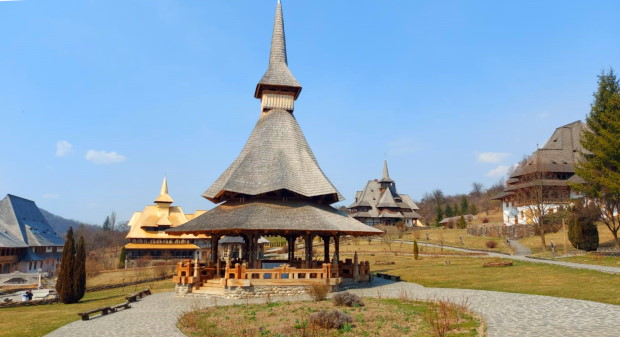
If you want to take a few moments to release your spiritual self, then Bârsana Monastery should be on your list. Situated in the heart of Maramureș, this little piece of Heaven is actually a complex of traditional monuments decorated with various flowers.
The entrance is under the bell tower, on the side of which you will find the complex map. Take a leisurely stroll through the courtyard and visit the Museum, the Priory, the Voivodeship House, the Summer Altar, and the two-levelled Church.
At this monastery, you’ll find the proper space to meditate and enjoy nature’s sounds.
Have a good laugh at The Merry Cemetery of Sapanta

Spirituality and religion are essential in Maramures. Yet, in one of its famous villages, Sapanta, you’ll find an extremely rare cemetery where you can actually giggle. Unlike most cemeteries in the world, the Merry Cemetery has a unique approach to death, seeing it as a celebration of a life that ended rather than a tragic event.
It all started in 1930 when one of the locals, Stan Ion Patras, carved the first oak cross. Since then, every cross in the cemetery has been painted in a special blue tone, known now as “Sapanta blue,” and it is also decorated with plenty of traditional motifs.
On the cross, you can see a painting meant to depict a personality trait or a significant moment from the life of the person who died and a short poem full of wit. One of the most famous crosses from the cemetery belongs to Stan Ion Patras himself. He died in 1977 and left the legacy of making peculiar crosses to his disciple.
While you’re here, take a few hours to explore the messages on each cross so you can take your dose of fun and laughter.
Find out the sad history of The Memorial of Suffering (Memorialul durerii) from Sighetu Marmației

The people of Maramureș are welcoming and full of warmth, even if history wasn’t always good to them.
In 1950, Sighetu Marmației lived the darkest year when many representatives of the Romanian elites, opponents of the new communist regime were imprisoned in the city prison. We are talking about ministers, members of the government, leaders of historical parties, generals, academics, men of letters, bishops of the Greek Catholic Church, and so on.
Nowadays, you’ll find The Memorial of Suffering instead of the old prison. This museum, the first-ever dedicated to the victims of communism, reconstructs and analyzes the painful past of those dark years of Romanian history.
You’ll be able to see collections of pictures, documents, objects, letters, newspapers, books, textbooks, albums, and oral history records– to give a complete picture of the struggle against communism.
What to do in Maramures? Venture to Cailor Waterfall
Nothing compares to a good hike on a nice summer day. That’s why you should spend at least one night at Borșa. Near this resort, you’ll find the biggest waterfall in Romania, called “Cascada Cailor.” As a part of the Rodna Mountains National Park, this waterfall, about 90 meters long, is indeed one of the most stunning waterfalls Romania has to offer.
There are two ways to get there. If you love long walks in nature, surrounded by beauty and color, you can follow a path and go on foot. For those who like seeing the world from above, a chairlift might be the best option.
The trip is worth it since you’ll be impressed by the waterfall’s natural location and the legends surrounding it. It is said that the name of this place comes from a true event that happened in the past. The locals say there was a massive storm, and the horses from the local studs were cornered by a bear, precisely on the plateau where the waterfall is formed today. Scared and helpless, the only thing that horses did was throw themselves into the void, perishing under the eyes of the bewildered bear.
In the memory of that event, the locals named several places after the horses: Horse Bridge, Horse Waterfall, Horse Spring, and Horse Mountain, all fantastic places to visit.
Explore the traditional village of Breb

If you want to experience how Romanian people lived before modern times, then Breb village is a must. Praised by many as the most authentic village in Maramureș, Breb has a lot of traditional experiences to offer. The landscape is picturesque, as the village is located at the foot of the Rooster Crest in the Gutai Mountains.
This village is the symbolic place for all the things that represent Maramures: wooden houses, a church from the 16th century, hospitable people, and good food. Here you can experience the local culture by walking through the village, meeting the locals, hearing their stories, and also participating in traditional activities such as working the land or picking vegetables in the garden. If you’re lucky enough you can even attend a traditional wedding and take part in local customs and rituals.
In this part of Romania, people still dress in their traditional costumes whenever they go to church. You can even try these colorful clothes as the locals are more than happy to offer you an authentic experience.
So, if you are looking for a peaceful life in the village and you dream of relaxing moments in the middle of nature, then the land Breb is what you are looking for.
Ready to visit Maramures? Choose one of the Secret Romania tours that take you there:
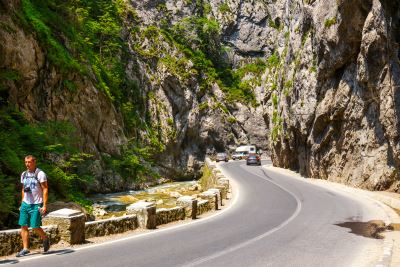
10 days in Romania itinerary

2 weeks in Romania Unesco tour

9 days in Romania – Bucovina & Maramures tour
9 days in romania - tour of bucovina & maramures, experience a magical christmas in maramures.
Maramures is beautiful every season, but wintertime is when all the magic happens. The first snowflakes that fall on the traditional houses, but also the old wooden fences and hills turn every village into a fairytale place.
People of this county care deeply about traditions and customs that take place around this time of the year. This is why you’ll have an unforgettable Christmas holiday, enjoying the hospitality and kindness of the people, tasting delicious dishes, and admiring the beautiful landscapes.
Read also: Top things to do in winter in Romania
As Christmas represents the most important holiday for Romanian people, every person no matter the age is going to participate in the preparations. Three main parts highlight the Christmas holiday.
Preparation:
Here the locals clean their houses, the yard, and also the graves of their loved ones.
Christmas Eve in Maramures:
Everyone is gathering to prepare delicious homemade food from pork meat, like sausages, lard, and the famous sarmale. After everything is ready, everyone will start caroling and visiting every house. They receive as a gift, bagels , nuts, and apples.
Celebrating Christmas:
The celebration takes 3 days and during this time people attend the church service dressed in their traditional costumes. After learning how to sing Romanian carols you can go caroling yourself with the locals.
So, if you’re planning a trip to Romania soon, make sure you’ll have the time to explore the northern part of the country. Rich in traditions and costumes, the people of Maramures will be more than happy to welcome you into their lovely homes, giving you the most authentic experience of living in the countryside.
You may also like:
Username or email address *
Password *
Lost your password? Remember me
No account yet?
Privacy Overview
Maramures Tours
Want to book a tour, we specialise in tours of maramures..
We have learned that some people like to visit the Village Hotel with all things included and organized well in advance. This means you don’t have to worry about anything when your on one of our tours or what the best things to see or experience, it’s all taken care of. Having lived in Maramures now for seven years we know our way around. We have discovered little gems of life, tucked away that no one else knows about. I have put all my knowledge of the region into five different tours that I think bring out the best of the region. Our Transylvania Tours are tried and testing and run 90% as planned. For example on our Dancing with the Gypsies tour, you never quite know who will be around in some of the villages we visit to learn how to dance. This is the wild part of Romania after all and why you are interested in visiting the region.
You will not meet people in the tourist businesses dressed up to look like locals in traditional costume. You will spend your time with locals working the land, with real Gypsies and old people from the villages that live the same way as there ancestors did many years before.
They work to a different mentality which is all part of the experience. Our Transylvania Tours include all costs apart from: your flights, any tipping you may choose to give (not recommended) and any bar bills you manage to tot up around the country. All alcohol consumed whilst in Breb is included in the cost. You do not have to pay or worry about anything for your entire stay. You are met at the airport and we make sure everything goes as planned until you catch your flight back home. Make a booking enquiry
10 days tours
100% maramures – maramures.
100% means you spend all your time in the depths of Maramures, we take your right into the homes of locals that have not changed their ways much in over 100 years. Experience a life gone by in the rest of Europe at an easy pace from the comfort of your own villa in the sleepy village of Breb.
Maramures Walking Tour – Villages around Maramures
Are you a walker? More interested in walking through villages and a way of life that is completely different to your own than mountain tops and forests? if so this tour is for you. We walk every day in a different village in Maramures taking it all in and stopping to talk to who ever we meet.
Dracula – Transylvania Tour – Cluj Napoca – Hotel Castle Dracula – Maramures
Romaniain ski holiday – cluj napoca – – breb – cavnic.
If you have a group of people who want to learn to ski, Cavnic ski resort is perfect for this. We have great instructors that speak English and empty slopes during the day. Combine skiing with staying at the Village Hotel 25 minutes from the slopes.
Sheppards Safari – Mountains of Maramures
Like in Siwa, here in Transylvania, we know the best local guides, the ones who really know their way around the mountains, and of course, we know the shepherds.
Dancing with the Gypsies – Tagu Mures – Maramures – Transylvania
If you want a bit of an adventure and are interested in learning to dance like a gypsy, then this tour is for you.
Reportage Photography tour – Cluj Napoca – Maramures – Transylvania
I was a professional portrait photographer for 15 odd years working for newspapers and magazines in London. I know my way around and I will get you into the homes and lives of the villages of Maramures and Transylvania in a way that no other guide know how 🙂
Ukrain & Transylvania – Kiev – Maramures – Cluj Napoca
As much desert and spectacular sand dunes as you can cope with, mixed in with the Berber culture in somewhere truly different.
Maramureş Travel Guide
Book your individual trip , stress-free with local travel experts
Select Month
- roughguides.com
- Travel guide
- Itineraries
- Local Experts
- Travel Advice
- Accommodation
Plan your tailor-made trip with a local expert
Book securely with money-back guarantee
Travel stress-free with local assistance and 24/7 support
Romania has been described as a country with one foot in the industrial future and the other in the Middle Ages – that’s still true enough of Maramureş, crammed up against the borders with Hungary and Ukraine and little changed since Dacian times. Within 30km of industrial Baia Mare , forested mountains and rough roads maintain scores of villages in almost medieval isolation, amid rolling hills with clumps of oak and beech and scattered flocks of sheep.
Maramureş funerals
Southern maramureş, wooden churches.
The county’s main attraction is its villages , with their superb wooden houses and churches, and traditional way of life. Every family occupies a compound with its livestock, fenced with timber, brush or latticework, and entered via a beamed gateway ( poarta ), the size of which indicates the family’s status and prosperity. Nowhere else in Europe do folk costumes persist so strongly, men wearing tiny clop straw hats and medieval rawhide galoshes ( opinchi ) or archaic felt boots bound with thongs, and women weaving boldly striped catriniţa aprons of cloth from the water-powered fulling mills. It is the women who embroider the wide-sleeved cotton blouses worn by both sexes – most conspicuously during markets and festivals . Villagers have retained their traditional religion (Orthodox rites alloyed with pagan beliefs), myths and codes of behaviour.
Most interesting of all is the marvellous woodwork of Maramureş: the gateways, many elaborately carved with symbols such as the Tree of Life, sun, rope and snake, continue to be produced today, and are rivalled only by the biserici de lemn or wooden churches , mostly built during the eighteenth century when this Gothic-inspired architecture reached its height – Maramureş has the finest examples in all of Eastern Europe, their fairy-tale spires soaring from humpbacked roofs. While some wooden churches are in a poor state, around twenty of the most valuable have been restored in recent years, and eight are on UNESCO’s World Heritage List. In recent years many new monasteries have also been constructed, in a modern version of the traditional style. Wooden houses, on the other hand, are vanishing from Maramureş villages, as modern homes are built and old timbers sold off to panel bars across Western Europe.
It’s particularly worth making the effort to see the towering wooden church at Şurdeşti , the beautiful church paintings at Bârsana , Rogoz and Deseşti , the frescoes and icons of Călineşti and Budeşti , the superb prison museum in Sighet and the quirky “Merry Cemetery” at Săpânţa . Further afield in the Iza valley, the visions of hell painted inside the church at Poienile Izei are the most striking images you’ll see in Maramureş, while the frescoes at Ieud are the most famous. There’s also good hiking in the peaceful Rodna and Maramureş mountains on the borders with Bucovina and Ukraine.
Travel ideas for Romania
Created by local experts

Relaxing beach fun - the Black Sea Coast in Bulgaria and Romania
The perfect trip for those that are looking for sun, sea and sand while also getting to know the culture and history of both Bulgaria and Romania. Start and end in Bucharest and discover Constanta, Sunny Beach, Nessebar, Burgas and Madara Rider.

The legend of Dracula
Transylvania is known to be the land of Dracula. Are you curious to visit the places mentioned in the book and the castles that hosted the major life events of Vlad the Impaler, the cruel ruler known as Dracula? Explore mysterious places and breathtaking landscapes all over Romania.

Luxurious Highlights of Romania: From Bucharest to Transylvania
Romania offers plenty for the discerning traveller, including beautiful Boutique properties. On this trip, discover Bucharest, the Danube Delta, Bucovina and Transylvania with Dracula's castle. A private guide will accompany you throughout the trip, well-equipped with Romanian knowledge and facts.

World Heritage in Romania and Bulgaria
Discover the most important UNESCO heritage sites in Romania and Bulgaria as well as some lesser-known attractions. From the capital Sofia to Plovdiv and Nessebar, as well as Veliko Tarnovo in Bulgaria to Romania's capital Bucharest to Sibiu, Cluj and Dracula's castle in Brasov.

Delicacies in Romania: food & wine
Perfect for foodies with little time - spend 5 days in Romania between Bucharest and Brasov, home to the famous Dracula castle. On the way, you will pass by vineyards and wineries, with tasting arrangements available for you. A private guide will be with you all throughout the trip.

Grand Eastern-European Tour
The gems of Central and Eastern Europe within 14 days: visit the capital cities Vienna, Budapest, Bucharest, and Sarajevo as well as famous Mostar in Herzegovina and Dracula's castle in Romania.
To the south of the Gutâi and Igniş mountains, BAIA MARE , the largest town in Maramureş, makes a good base for forays into the surrounding countryside. Mining has been important here since the fourteenth century when, under its Magyar name of Nagybánya (“big mine”), it was the Hungarian monarchs’ chief source of gold, but it remained a small town until the communists turned it into a major nonferrous metals centre in the 1950s, diluting its largely Hungarian population to just fourteen percent of the total. The town has an attractive old core, now largely restored, and some worthwhile museums, in particular the Art Gallery and Village Museum .
The heart of Baia Mare’s old town is Piaţa Libertăţii , a beautifully restored square lined with sixteenth- to eighteenth-century houses; it is now pedestrianized, along with parts of the neighbouring streets, and there are plenty of bars along its south side. At no. 18, the thick-walled Casa Elisabeta was begun by Iancu de Hunedoara, fifteenth-century Regent of Hungary, for his wife, and completed by their son, Matei Corvin; next door is the house where the great Hungarian actor Lendvay Márton was born in 1807. On the west side of the square a lovely Secession hotel is now the newly refurbished Cinematograful Minerul. To the south of the square rises the 40m-high Stephen’s Tower , built in 1442–46 and all that remains of a Roman Catholic cathedral that burned down in 1769; the adjacent Baroque pile, built by the Jesuits in 1717–20, then became the city’s cathedral. Immediately north of Piaţa Libertăţii, at the junction of Strada Monetăriei and Strada Podul Viilor, is the landmark Reformat church , built in 1809 and topped by what seems to be a giant red diver’s helmet, which appears in many paintings by the Nagybánya School. Other than the museums listed in this account, the modern Muzeul de Mineralogie (Museum of Mineralogy; B-dul Traian 8; Tues–Sun 9am–5pm), towards the stations, is also worth a quick look.
The Chestnut Festival (Sărbătoarea Castanelor), held over the last weekend of September, celebrates – naturally – the chestnut season, with exhibitions, a riotous beer festival and traditional music on the Sunday.
The Nagybánya School
The Nagybánya School (using the Hungarian version of Baia Mare’s name) was responsible for transforming Hungarian art at the close of the nineteenth century. Its founder was Simon Hollósy (1857–1918), born of Armenian stock in Sighet and trained in Munich, where he was influenced by the refined naturalism of Jules Bastien-Lepage. In 1886 he set up his own school in Munich, and from 1896 brought his students to a summer school in Baia Mare. An exhibition in 1897 of the school’s paintings was seen as marking the start of a new era in Hungarian art and the school became known as the “Hungarian Barbizon”, although the area’s motifs and colours were closer to those of Provence.
In 1902, Hollósy suffered a creative crisis, and the leadership of the school was taken over by Károly Ferenczy ; tuition fees were abolished, and the embittered and jealous Hollósy left to set up a rival school in Técső, now the Ukrainian town of Tyachiv, just downstream of Sighet. Ferenczy suffered a similar crisis in 1910, and did little work thereafter. Of the second generation of artists, the most gifted was Cavnic-born Jenő Maticska (1885–1906). After his untimely death, Béla Czóbel, Csába Vilmos Perlrott, Sándor Ziffer and others revolted against creeping stagnation; their 1906 exhibition, influenced by Cézanne, Matisse and German Expressionism, again marked the start of a new era in Hungarian art. After World War I the school was opened to both Hungarian and Romanian students – up to 150 a year – but interest faded in the 1930s and the school closed its doors.
The Cult of the Dead is central to the culture of Maramureş, where rituals are fixed and elaborate; if anything is omitted, it’s believed that the soul will return as a ghost or even a vampire. There are several phases, covering the separation from the world of the living, preparation for the journey, and entry into the other world. A dying person asks forgiveness of his family and neighbours, who must obey his last wishes. Black flags are hung outside the house where the deceased lies for three days, while the church bells are rung thrice daily, neighbours pay their respects and women (but not men) lament the deceased in improvised rhyming couplets.
The wailing reaches a climax on the third day when the priest arrives and blesses a pail of water, extinguishes a candle in it, and consecrates the house with a cross left etched on the wall for a year. The coffin is carried by six married men, stopping for prayers (the priest being paid for each stop) at crossroads, bridges and any other feature along the way, and then at the church for absolution. The funeral itself is relatively swift, with everyone present throwing soil into the grave and being given a small loaf, a candle and a red-painted egg , as at Easter; these must also be given to passers-by, including tourists (be aware it would give great offence to refuse it). The knot-shaped loaves or colaci bear the inscription NI KA (“Jesus Christ is victorious”), stamped in the dough by a widow or some other “clean woman” using a special seal called a pecetar . The seal’s wooden handle is often elaborately carved with motifs such as the Endless Column, the Tree of Life, wolf’s teeth or a crucifix.
Three days later there is another pomană or memorial meal , when bread is again given to all present. After nine days, nine widows spend the day fasting and praying around the deceased’s shirt; six weeks and then six months after the funeral, the absolution is repeated with another meal, as the dead must be given food and drink, and after a year a feast is given for all the family’s dead. Until this time the close family may not attend weddings or dances and women wear black. As elsewhere in Romania, cergare (embroidered napkins) are hung over icons in the church or over plates on house walls in memory of the dead. The Uniates also remember their dead on All Souls’ Day.
Marriage is seen as essential, so much so that if a person of marriageable age (in fact from 8 years old, the age of first confession) dies unmarried, a Marriage of the Dead (Nunta Mortului) is held, with a stand-in bride or groom (as appropriate), and a bridesmaid or best man dressed in wedding costume, although everyone else wears mourning garb.
The southwestern corner of the present Maramureş county, beyond the River Someş, is known as Codrul ; immediately south of Baia Mare is Chioarul ; and further east lies Lăpuş . While the rolling green landscape is not as dramatic as in the north, it is delightful, and you could easily spend a couple of days pottering around the region’s fine wooden churches . Folk costumes here are similar to those of historic Maramureş, although the tall straw hats are unique to the region.
Târgu Lăpuş and around
Buses from Baia Mare run southeast only as far as the nondescript little town of Târgu Lăpuş , the hub of the Lăpuş area where many villages have wooden churches. There are various places to stay in Târgu Lăpuş, making it a good base for exploration.
The finest wooden churches in Lăpuş are the two in ROGOZ , 6km east of Târgu Lăpuş, which, despite the arrival of a modern church, remain well maintained: the Uniate church, built around 1695 in Suciu de Sus and moved here in 1893, stands in the grounds of the larger Orthodox church of the Archangels Michael and Gabriel, built of elm in about 1663. The latter is unique thanks to its naturalistic horse-head cantilevers supporting the roof at the west end, and its asymmetric roof, with a larger overhang to the north sheltering a table where paupers were fed. It’s one of the most beautifully decorated churches in Maramureş, with paintings by Radu Munteanu, notably a Last Judgement , to the left inside the door, and the Creation and the Good Samaritan , on the naos ceiling. Next to the church is a museum house created by the very entertaining priest (he speaks some French), displaying clothes, rugs and tools.
A swathe of wooden churches stretches across Eastern Europe, from northern Russia to the Adriatic, but in terms of both quality and quantity the richest examples are in Maramureş. From 1278, the Orthodox Romanians were forbidden by their Catholic Hungarian overlords to build churches in stone, and so used wood to ape Gothic developments. It was long thought that most were rebuilt after the last Tatar raid in 1717, acquiring large porches and tall towers, often with four corner-pinnacles, mimicking the masonry architecture of the Transylvanian cities. However in 1997 a tree-ring study showed that the wood used in many churches – notably those of Corneşti, Breb and Onceşti – was far older, the oldest dating from 1367.
In general, the walls are built of blockwork (squared-off logs laid horizontally), cantilevered out in places to form brackets or consoles, supporting the eaves. However, Western techniques such as raftering and timber framing enabled the development of characteristic high roofs and steeples in Maramureş. Following the standard Orthodox ground plan , the main roof covers the narthex and naos and a lower one the sanctuary; the naos usually has a barrel vault, while the narthex sits beneath the tower, its weight transmitted by rafters to the walls and thus avoiding the need for pillars. The main roof is always shingled and in many cases double, allowing clerestory windows high in the nave, while the lower roof may be extended to the west to form a porch (exonarthex or pridvor ).
Inside, almost every church has a choir gallery above the west part of the naos, always a later addition, as shown by the way it is superimposed on the wall paintings . These extraordinary works of art were produced by local artists in the eighteenth and early nineteenth centuries, combining the icon tradition with pagan motifs – such as ropes and suns – and topical propaganda against the invading Turks. They broadly follow the standard Orthodox layout, with the Incarnation and Eucharist in the sanctuary (for the priest’s edification), the Last Judgement and moralistic parables such as the Wise and Foolish Virgins in the narthex (where the women stand), and the Passion in the naos.
The first of the major painters was Alexandru Ponehalski , who worked from the 1750s to the 1770s in Călineşti and Budeşti, in a naïf post-Byzantine style with blocks of colour in black outlines. From 1767 to the 1780s, Radu Munteanu worked around his native Lăpuş and in Botiza, Glod and Deseşti, painting in a freer and more imaginative manner. A more Baroque style developed in the first decade of the nineteenth century, with Toader Hodor and Ion Plohod working in Bârsana, Corneşti, Văleni, Năneşti and Rozavlea.
Since 1989, there has been a renaissance of the Uniate or Greco-Catholic faith, repressed under communism and forcibly merged with the Romanian Orthodox Church: many parishes have reverted to Greco-Catholicism, reclaiming their churches; in others, one church is now Orthodox and the other Uniate, while in some villages the congregations even manage to share one church. Many villages have built large, new churches, making it more likely that you’ll find the wooden churches locked – even on a Sunday. Finding the key-holder can be problematic, but ask around and someone is bound to help out. People dress conservatively here, and wearing shorts is not appropriate for visiting churches.
Of about a hundred wooden churches in Maramureş, 35 are left in the north of the county and thirty in the south. Eight were placed on UNESCO’s World Heritage List in 1999: Bârsana, Budeşti (Josani), Deseşti, Ieud (Deal), Siseşti, Plopiş, Poienile Izei and Rogoz.
Discover more places in Romania
- Northern Maramureş
The Rough Guides to Romania and related travel guides
In-depth, easy-to-use travel guides filled with expert advice.

Find even more inspiration for Romania here

Planning your own trip? Prepare for your trip
Use Rough Guides' trusted partners for great rates
written by Rough Guides Editors
updated 26.04.2021
Ready to travel and discover Romania?
Get support from our local experts for stress-free planning & worry-free travels.
- Where to stay
- Travel advice

IMAGES
COMMENTS
This is a 2-day trip (can be extended to 3 days) from Cluj-Napoca with a flexible itinerary so you see the best of Maramures region! All-inclusive: all transport, 1 night stay in local guesthouse, half board, entrance fees to 3 sights and special tasting event. We will visit 2-3 UNESCO Wooden Churches, the Victims of Communism Memorial in ...
Discover the rich heritage of Romania with our 8-day tour of Bucovina and Maramures. Explore UNESCO sites like the Painted Monasteries and Wooden Churches, experience local traditions, and enjoy the natural beauty of Romania's historic regions. Book your cultural journey today and immerse yourself in the heart of Romanian history and folklore.
Open now. 12:00 AM - 11:59 PM. Write a review. See all photos. About. Custom guided tours around Maramures (the Europe's best preserved corner with a genuine traditional way of life), Bucovina and Moldova (mostly known for their impressive monasteries, some with exterior frescoes), and Transylvania (with its castles, cities or fortified ...
The average group size for Maramures Tours is small, offering an intimate experience. They provide a private tour option for those seeking a more personalized journey. ... With expert guides, delicious meals, and convenient inclusions, this journey promises to be a memorable and insightful experience that will leave you with a newfound ...
Recommended by Lonely Planet and Rick Steves Europe, I have 20 years of expertise in quality private tours for very small groups.. Join me to discover Maramures (Europe's best preserved corner with a genuine traditional way of life), Bucovina and Moldova (mostly known for their great painted monasteries), Transylvania (with its castles, old cities, and fortified churches), or other destinations.
Embark on a 9-day adventure exploring the cultural treasures and historic sites of Maramures and Transylvania. This comprehensive tour offers a deep dive into the region's rich heritage, from the iconic wooden churches of Maramures to the medieval citadel of Sighisoara and the legendary castles of Transylvania.
Private tour of Maramures, starting at 300 EUR/person/day. Make an enquiry. Maramures, the ultimate bucolic nest of Europe. Escape modernity, in comfort, on a discovery journey through wild landscapes and enchanting villages. Witness a way of life that has disappeared from almost every corner of Europe and experience some of the finest ...
Even better, Maramures offers great outdoors, perfect for walking, cycling, and hiking, our favorite ways to visit Maramures. Without further ado, here's our list of the best things to do in Maramures, the 'land of wood'. 1. Walk or cycle from village to village. This is the best way to visit Maramures, following the routes villagers used ...
Maramures Tour is a 2 - day private tour that will allow you to step back in time and discover the soul of rural Romania. The region of Maramures preserved the culture, traditions, and lifestyle of the peasants from a romantic era of simplicity, pride, and moral values. To get to Maramures we will travel on picturesque mountain roads, rolling ...
Maramures Tours. Custom guided tours around Maramures (the Europe's best preserved corner with a genuine traditional way of life), Bucovina and Moldova (mostly known for their impressive monasteries, some with exterior frescoes), and Transylvania (with its castles, cities or fortified churches, but also sheltering diverse ethnic groups).
Maramures best (1 day, from Cluj) Highlights: - scenic road across the Carpathian Mountains - amazing haystacks landscape - 2 UNESCO heritage wooden churches…. 2. Maramures Guided Tour. Maramures is the region where ancient traditions, the folk costumes and old art are preserved like nowhere else in Romania…. 3.
3 Day Tour of Maramures. Accompanied by a truly local expert, who has written 6 books about his region and has been guiding for almost 20 years, you will visit the region's famous landmarks (such the Merry Cemetery, Barsana monastery, the wooden churches or the Memorial Museum and Elie Wiesel House) but also places off the beaten path: local ...
Immerse yourself in the landmarks and culture of Romania with this full day guided tour. Visit famous landmarks including the Merry Cemetery, Memorial Museum or Monasteries. Explore further and meet locals. Shop at small markets and meet artisans hard at work while learning how the community functions. Tour highlights include visiting the remaining medieval hay fields tended to by self ...
" Maramures Walking Tour ": The 3-5 walking days across Maramures can be done exclusively up in the mountains (including Rodna National Park, Maramureș Natural Park, and Băiuț virgin forests), at 1000-2300 m altitude, or you can walk between traditional villages on small paths and roads, reaching also the ridges that separate the ...
Maramures is considered by many the soul of the typical Romanian village. The picturesque villages, green hills, and fields full of wildflowers will make you feel like you went back in time. Maramures is a unique, slow tourism destination. It has carefully kept the traditions, the culture, and the lifestyle of peasants who lived in bygone ages.
But most tourists stay in Bucharest and tour Romania, including Transylvania and Maramures. Getting To Maramures By Train. Another option is to take the train from Bucharest (or any other major city in Romania) to Baia Mare. The ride takes around 13 hours, which is not your best option. But if you choose it, you can book your train tickets online.
1. Admire the Wooden Churches of Maramures. As these lands were once part of the Hungarian, Habsburg and later Austro-Hungarian Empire, Catholic religion was considered the official one. So the Romanian Orthodox population wasn't allowed to build stone and brick churches that would survive the test of time.
1. Maramures best (1 day, from Cluj) Highlights: - scenic road across the Carpathian Mountains - amazing haystacks landscape - 2 UNESCO heritage wooden churches…. 2. Maramures Guided Tour. Maramures is the region where ancient traditions, the folk costumes and old art are preserved like nowhere else in Romania…. 3.
Situated in the northern part of Romania, this region it's very well known for its welcoming people, amazing landscapes, and authentic wood architecture. Maramures is a wonderful place to visit if you want to enjoy an active holiday. The best ways to visit this county are walking, cycling, and hiking. You'll find dozens of hidden gems to ...
100% Maramures - Maramures. 100% means you spend all your time in the depths of Maramures, we take your right into the homes of locals that have not changed their ways much in over 100 years. Experience a life gone by in the rest of Europe at an easy pace from the comfort of your own villa in the sleepy village of Breb.
Plan your visit to Maramures, Romania: find out where to go and what to do in Maramures with Rough Guides. Read about itineraries, activities, places to stay and travel essentials and get inspiration from the blog in the best guide to Maramures. ... Plan your tailor-made trip with a local expert. ... Grand Eastern-European Tour. The gems of ...
Mara International Tour. Mara International Tour este o agentie de turism cu sediul in Baia Mare, care ofera serviciile sale de turism tuturor maramuresenilor, de aproape 20 de ani. ... Baia Mare 430242, Maramures . [email protected] . 0744.380.184, 0262.221.038 ,0729.218.059 ...
Nestled within the rolling hills of Maramures, the guided tour beckons travelers with promises of a journey through time, where ancient traditions blend